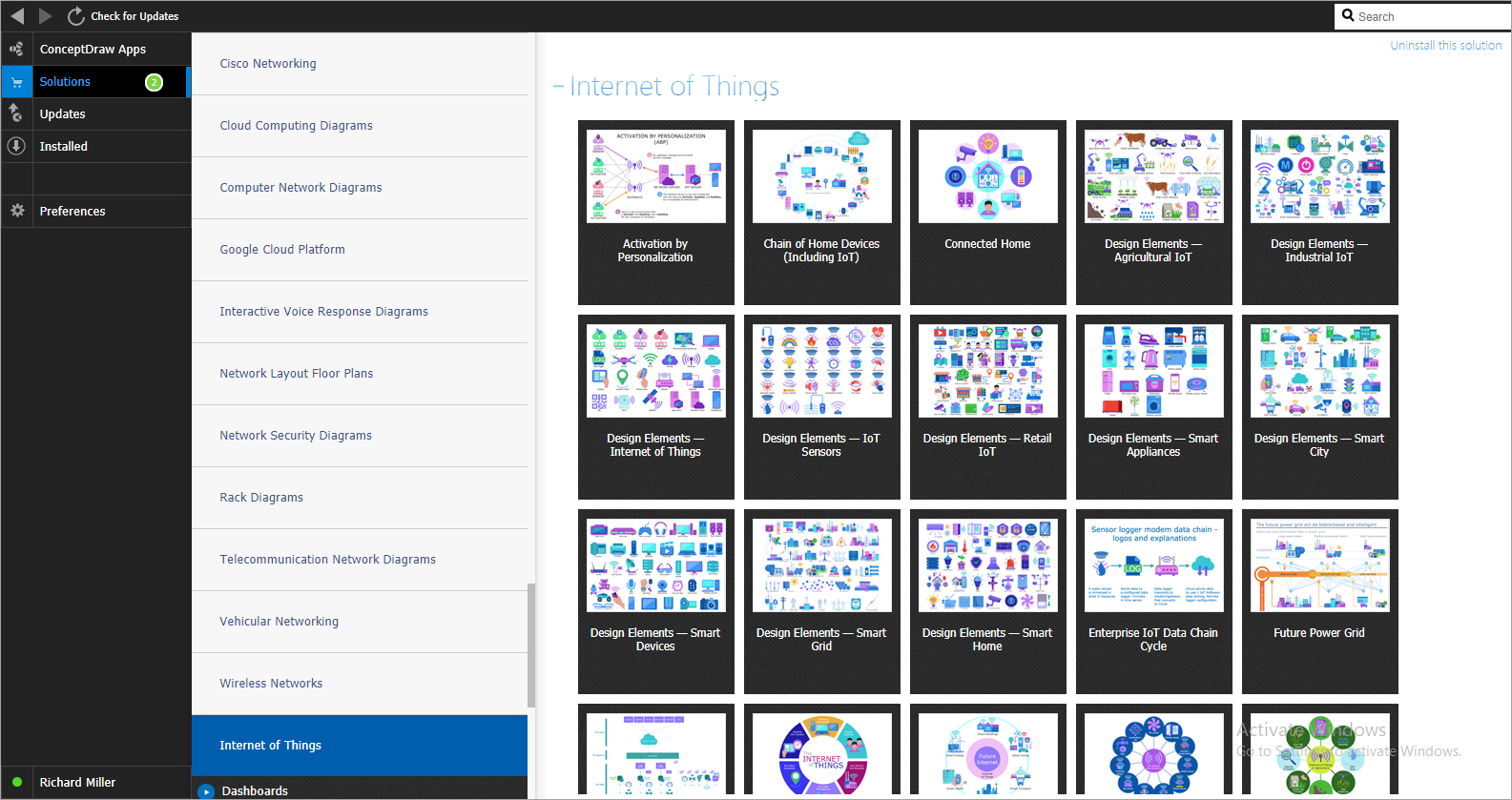- Electric and Telecom Plans Free
- Fire and Emergency Plans Free
- Floor Plans Free
- Plant Layout Plans Free
- School and Training Plans Free
- Seating Plans Free
- Security and Access Plans Free
- Site Plans Free
- Sport Field Plans Free
- Business Process Diagrams Free
- Business Process Mapping Free
- Classic Business Process Modeling Free
- Cross-Functional Flowcharts Free
- Event-driven Process Chain Diagrams Free
- IDEF Business Process Diagrams Free
- Logistics Flow Charts Free
- Workflow Diagrams Free
- ConceptDraw Dashboard for Facebook Free
- Mind Map Exchange Free
- MindTweet Free
- Note Exchange Free
- Project Exchange Free
- Social Media Response Free
- Active Directory Diagrams Free
- AWS Architecture Diagrams Free
- Azure Architecture Free
- Cisco Network Diagrams Free
- Cisco Networking Free
- Cloud Computing Diagrams Free
- Computer Network Diagrams Free
- Google Cloud Platform Free
- Interactive Voice Response Diagrams Free
- Network Layout Floor Plans Free
- Network Security Diagrams Free
- Rack Diagrams Free
- Telecommunication Network Diagrams Free
- Vehicular Networking Free
- Wireless Networks Free
- Internet of Things $30
- Comparison Dashboard Free
- Composition Dashboard Free
- Correlation Dashboard Free
- Frequency Distribution Dashboard Free
- Meter Dashboard Free
- Spatial Dashboard Free
- Status Dashboard Free
- Time Series Dashboard Free
- Basic Circle-Spoke Diagrams Free
- Basic Circular Arrows Diagrams Free
- Basic Venn Diagrams Free
- Block Diagrams Free
- Concept Maps Free
- Family Tree Free
- Flowcharts Free
- Basic Area Charts Free
- Basic Bar Graphs Free
- Basic Divided Bar Diagrams Free
- Basic Histograms Free
- Basic Line Graphs Free
- Basic Picture Graphs Free
- Basic Pie Charts Free
- Basic Scatter Diagrams Free
- Aerospace and Transport Free
- Artwork Free
- Audio, Video, Media Free
- Business and Finance Free
- Computers and Communications Free
- Holiday Free
- Manufacturing and Maintenance Free
- Nature Free
- People Free
- Presentation Clipart Free
- Safety and Security Free
- Analog Electronics Free
- Audio and Video Connectors Free
- Basic Circuit Diagrams Free
- Chemical and Process Engineering Free
- Digital Electronics Free
- Electrical Engineering Free
- Electron Tube Circuits Free
- Electronic Block Diagrams Free
- Fault Tree Analysis Diagrams Free
- GHS Hazard Pictograms Free
- Home Automation and Wiring Free
- Mechanical Engineering Free
- One-line Diagrams Free
- Power Сircuits Free
- Specification and Description Language (SDL) Free
- Telecom and AV Circuits Free
- Transport Hazard Pictograms Free
- Data-driven Infographics Free
- Pictorial Infographics Free
- Spatial Infographics Free
- Typography Infographics Free
- Calendars Free
- Decision Making Free
- Enterprise Architecture Diagrams Free
- Fishbone Diagrams Free
- Organizational Charts Free
- Plan-Do-Check-Act (PDCA) Free
- Seven Management and Planning Tools Free
- SWOT and TOWS Matrix Diagrams Free
- Timeline Diagrams Free
- Australia Map Free
- Continent Maps Free
- Directional Maps Free
- Germany Map Free
- Metro Map Free
- UK Map Free
- USA Maps Free
- Customer Journey Mapping Free
- Marketing Diagrams Free
- Matrices Free
- Pyramid Diagrams Free
- Sales Dashboard Free
- Sales Flowcharts Free
- Target and Circular Diagrams Free
- Cash Flow Reports Free
- Current Activities Reports Free
- Custom Excel Report Free
- Knowledge Reports Free
- MINDMAP Reports Free
- Overview Reports Free
- PM Agile Free
- PM Dashboards Free
- PM Docs Free
- PM Easy Free
- PM Meetings Free
- PM Planning Free
- PM Presentations Free
- PM Response Free
- Resource Usage Reports Free
- Visual Reports Free
- House of Quality Free
- Quality Mind Map Free
- Total Quality Management TQM Diagrams Free
- Value Stream Mapping Free
- Astronomy Free
- Biology Free
- Chemistry Free
- Language Learning Free
- Mathematics Free
- Physics Free
- Piano Sheet Music Free
- Android User Interface Free
- Class Hierarchy Tree Free
- Data Flow Diagrams (DFD) Free
- DOM Tree Free
- Entity-Relationship Diagram (ERD) Free
- EXPRESS-G data Modeling Diagram Free
- IDEF0 Diagrams Free
- iPhone User Interface Free
- Jackson Structured Programming (JSP) Diagrams Free
- macOS User Interface Free
- Object-Role Modeling (ORM) Diagrams Free
- Rapid UML Free
- SYSML Free
- Website Wireframe Free
- Windows 10 User Interface Free
Internet of Things
The Internet of Things (IoT) is a system of interconnected physical objects supplied with sensors, software, and other electronic technologies to transfer and exchange data via the Internet or other communication networks. IoT include computing devices, mechanical machines, automobiles with built-in sensors, digital devices with processors, sensors, and other objects with assigned individual identifier or IP address.
IoT is an incredibly popular and useful technological development of the 21st century. Currently, it is one of the most important technologies of everyday life and is used in multiple devices and industries including manufacturing, automotive, transportation, logistics, retail, public sector, agriculture, medicine and healthcare, veterinary. Billions of IoT devices around the world make it smarter, provide more efficient operation of enterprises, real-time data communication without involving a human, improve security and customer service, medical diagnostics, education, and decision-making, increase the value of businesses and keep them competitive.
The most common example of IoT technology is the smart home, which includes smart appliances, electronic devices, and equipment like home security systems, video surveillance devices, cameras, thermostats, sensors, lighting fixtures, interconnected and controlled with the electronic devices. Smart blackboards, medical equipment, biochip transponders, fitness devices, baby monitors, self-driving cars, wearable devices that help doctors monitor human health remotely are also examples of IoT. They include devices to track environmental conditions and health of workers employed in hazardous conditions in mines, chemical and power plants, oil and gas fields to improve their safety. IoT is actively used in logistics for fleet management, real-time remote monitoring vehicles, their rerouting based on weather conditions, tracking vehicles or drivers availability, detection failures in vehicles.
The use of IoT provides a competitive advantage for many businesses, enables reducing operating costs, provides production-line monitoring to track failures and get better uptime, machine and product-quality monitoring to identify and address quality defects, improve performance management, monitoring of temperatures and humidity that is crucial for many industries like pharmaceutical, food and beverage, floristic, and others.
The use of IoT in buildings helps to reduce energy costs, track temperature, and switch on/off the heating or air conditioning automatically. IoT-based smart farming systems are helpful in agriculture to automate irrigation systems using the information from the sensors about light, temperature, and soil moisture of crop fields. IoT sensors help to organize smart street lights, alleviate traffic, monitor and address environmental issues.
IoT in the public sector and service-related environments help to notify users about mass interruptions or outages in services, for example, water, power, etc., and recover faster through collecting up-to-date data. Retail companies obtain the possibility to manage inventory and optimize the supply chain to improve customer service.
Most IoT devices use cloud-based IoT applications and possess pre-built intelligent software-as-a-service applications to collect, analyze, and process data captured by IoT sensors. IoT applications help to analyze massive amounts of sensor data, statistic data, and key performance indicators in the cloud using machine learning algorithms and artificial intelligence. They assist in the identification of equipment failures and operation anomalies, run automated fixation and send alerts to users.
The Internet of Things solution extends ConceptDraw DIAGRAM with a set of samples and a wide collection of predesigned special clipart, pictograms, symbols of IoT sensors, IoT devices, smart appliances, retail, industrial, and agricultural IoT devices, and many other IoT objects. This solution is incredibly helpful for designing the Internet of Things (IoT) and Web of Things (WoT) diagrams and infographics of different complexity for numerous areas and industries. It is incredibly useful for engineers, designers, electricians, mechanics, developers, technicians, electronics, and safety-related specialists.
-
Buy this solution $30 -
Solution Requirements - This solution requires the following products to be installed:
ConceptDraw DIAGRAM v18 - This solution requires the following products to be installed:
-
Compatibility - Sonoma (14), Sonoma (15)
MS Windows 10, 11 - Sonoma (14), Sonoma (15)
-
Support for this Solution -
Helpdesk
The IoT solution has 10 libraries containing 274 objects that are used to illustrate the architecture and communication flow of IoT systems.
Design Elements — Internet of Things

Design Elements — Industrial IoT

Design Elements — Smart Grid
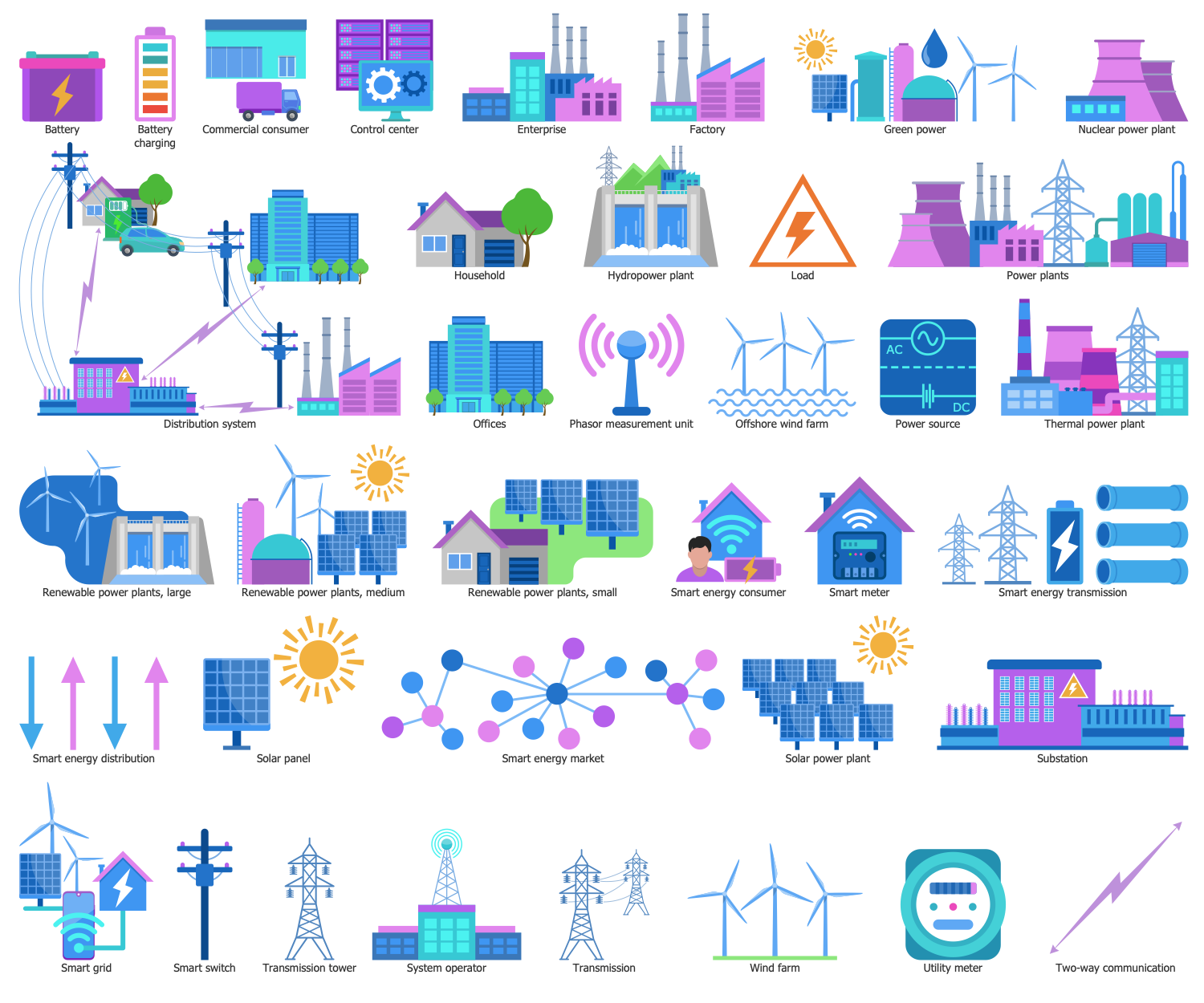
Design Elements — IoT Sensors
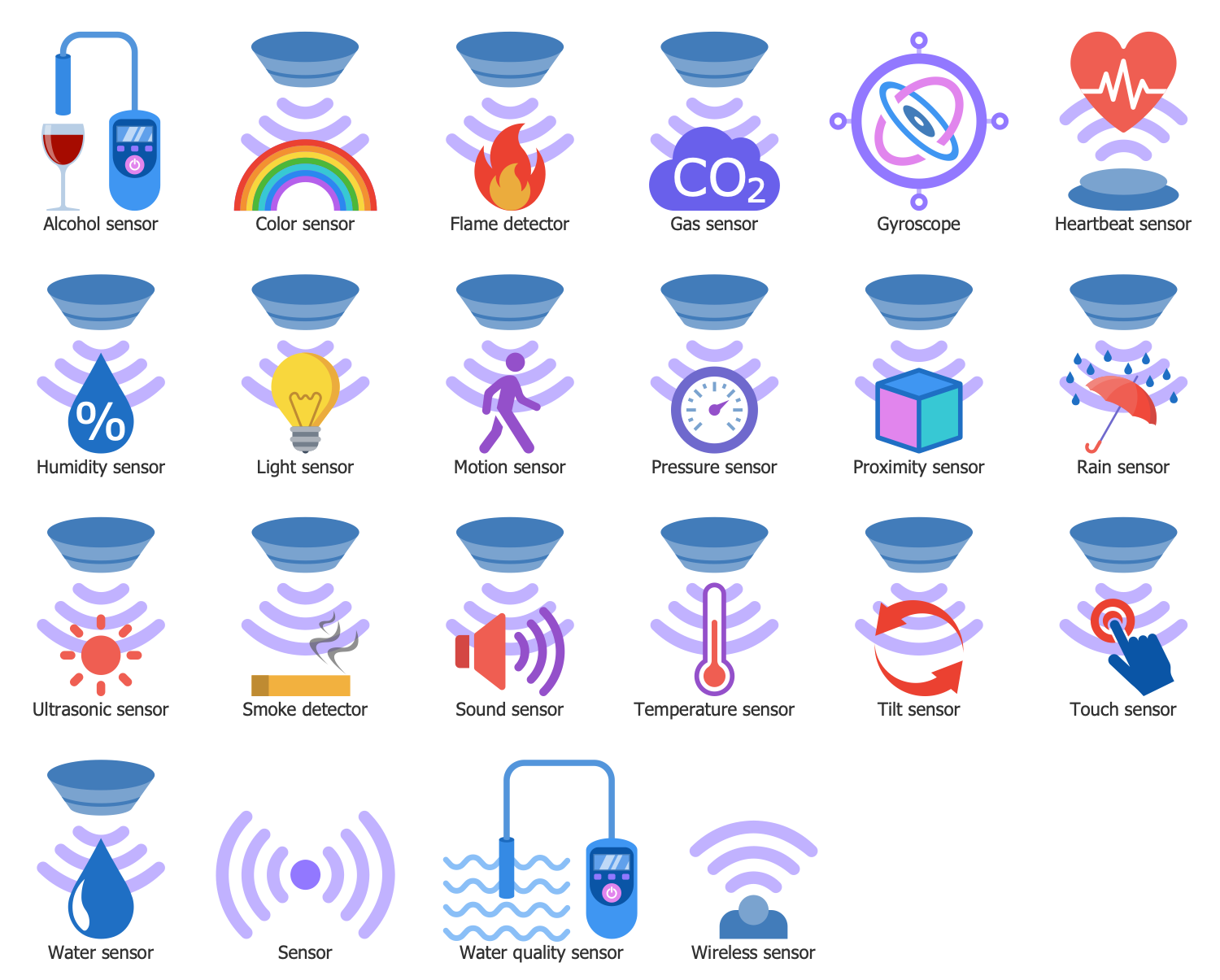
Design Elements — Retail IoT
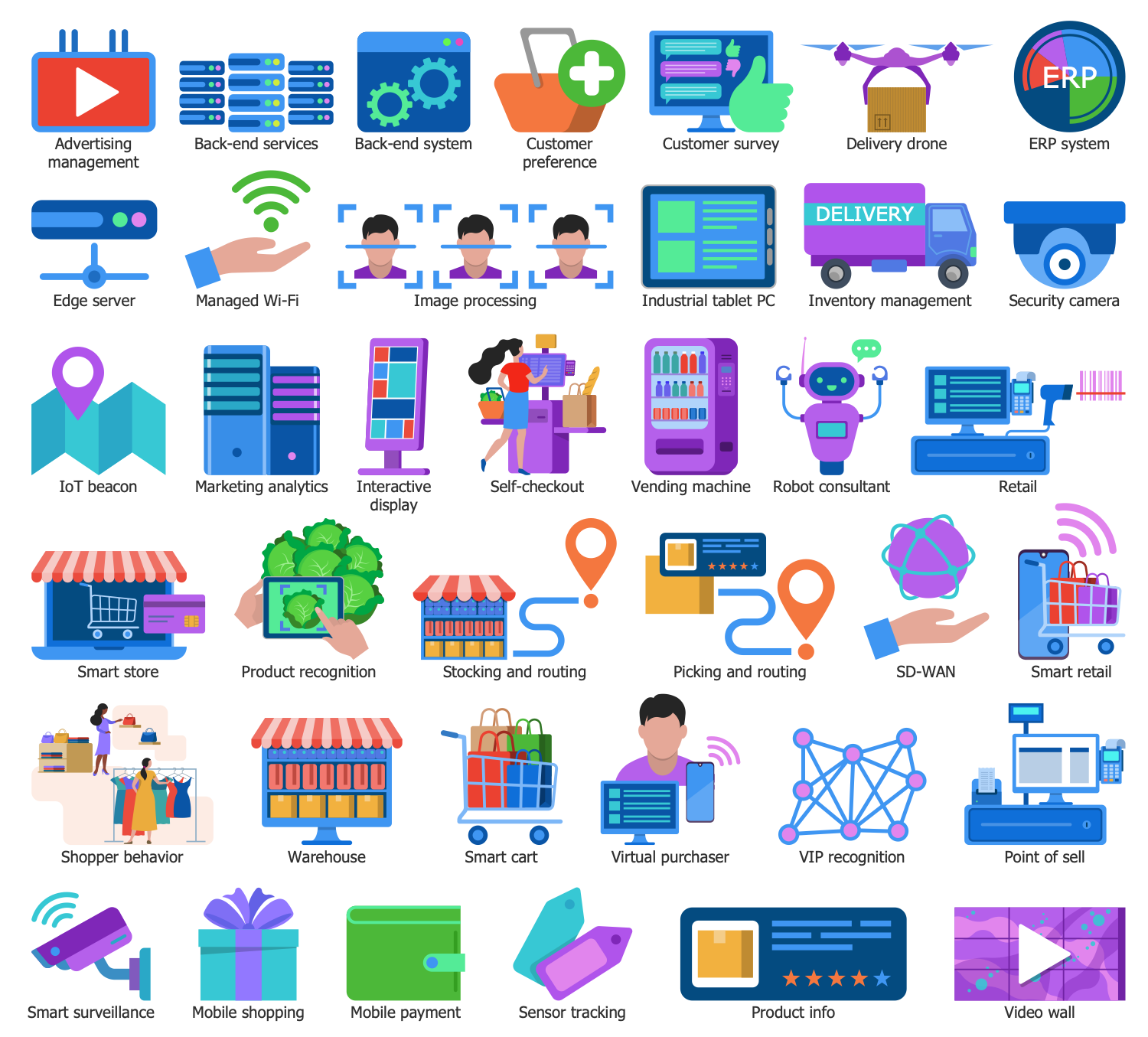
Design Elements — Smart City
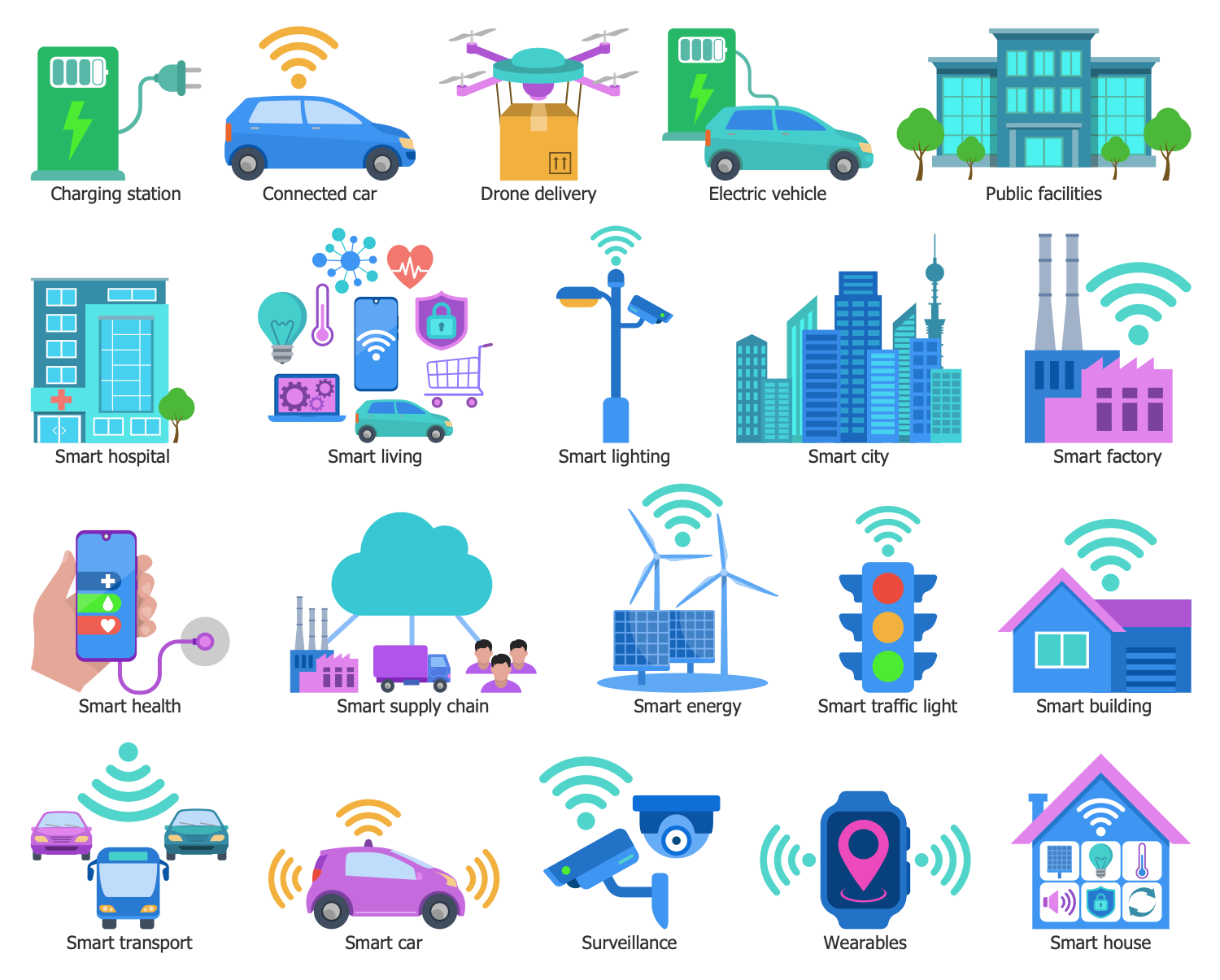
Design Elements — Smart Home

Design Elements — Smart Devices
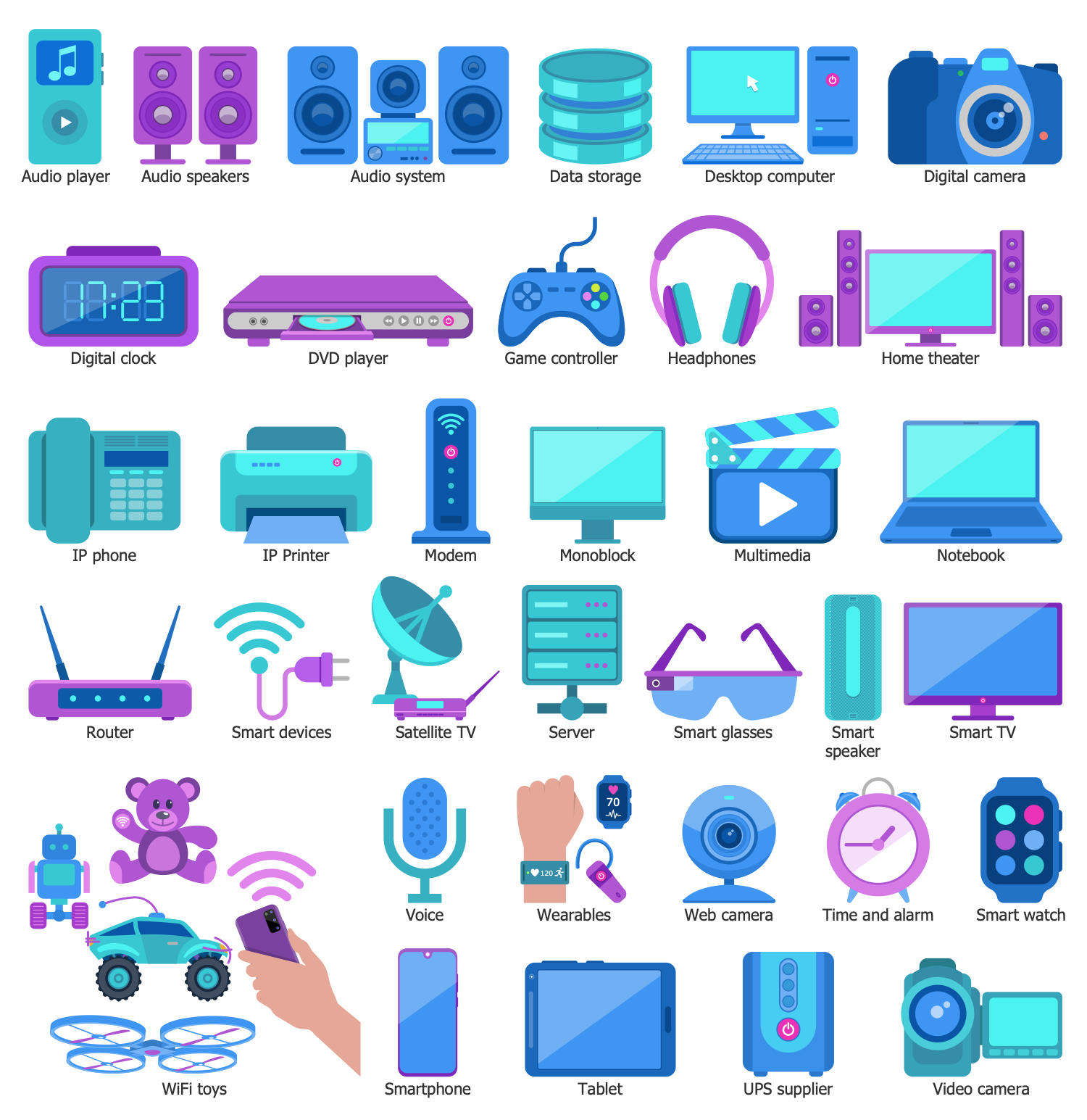
Design Elements — Agricultural IoT
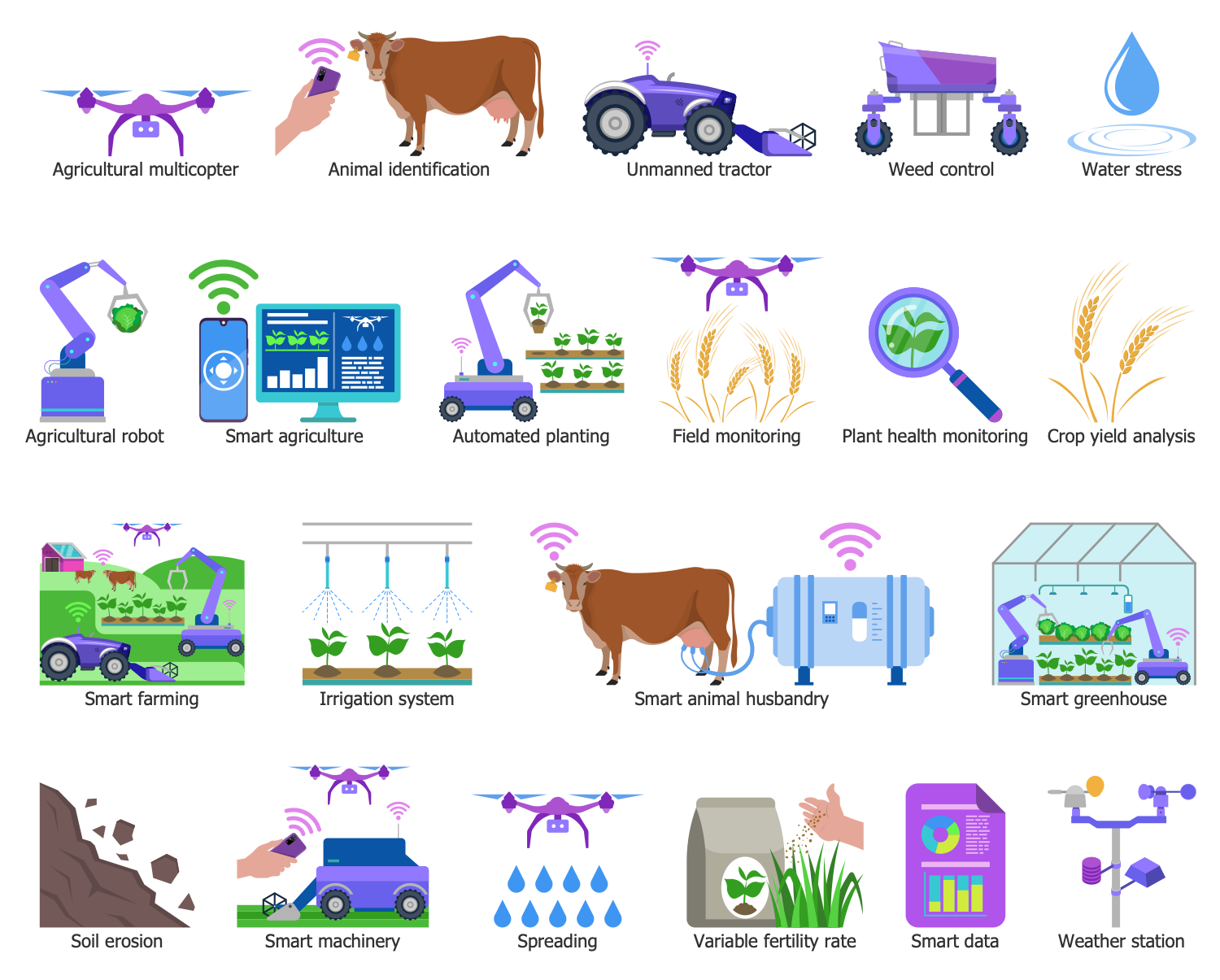
Design Elements — Smart Appliances
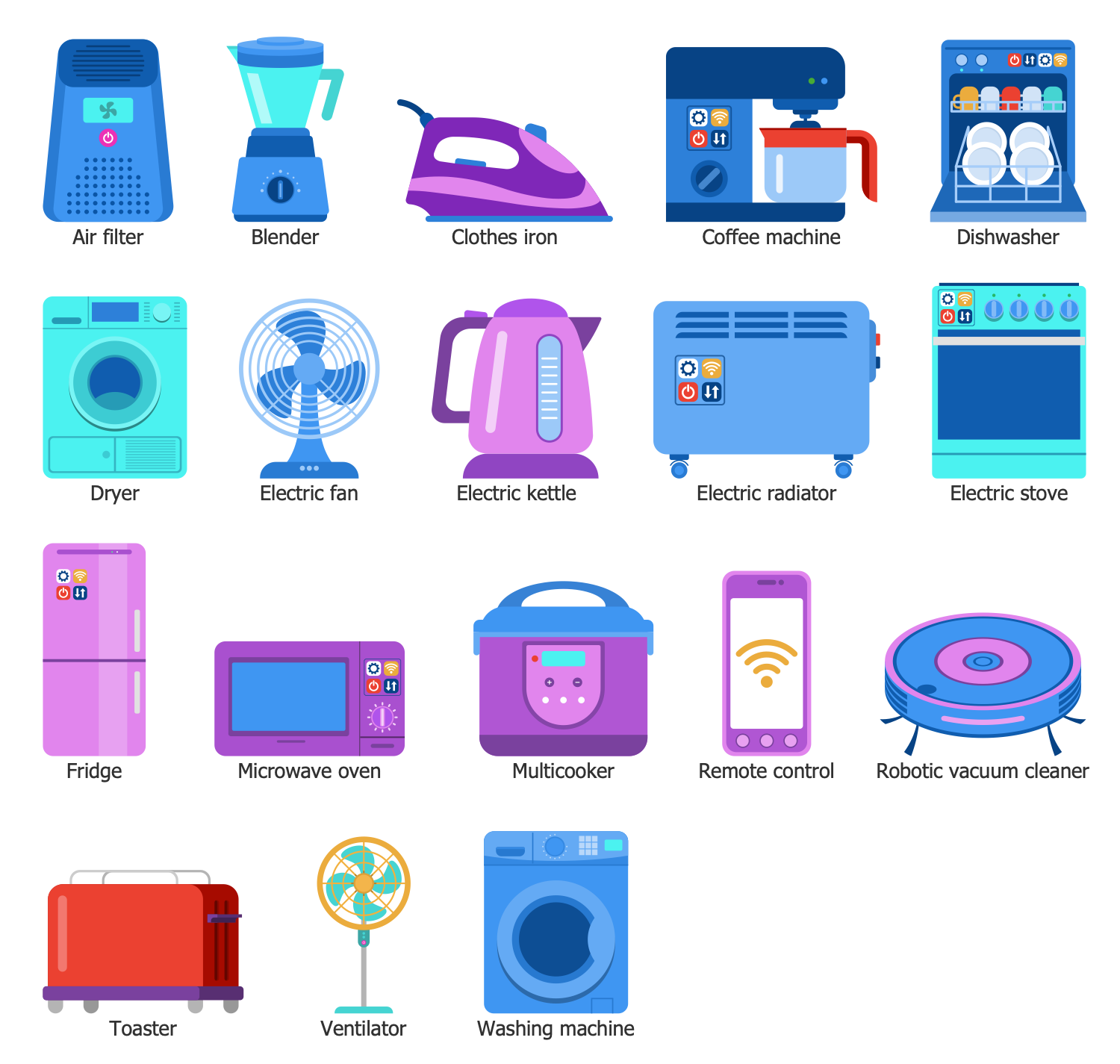
Examples
There are a few samples that you see on this page which were created in the ConceptDraw DIAGRAM application by using the Internet of Things solution. Some of the solution's capabilities as well as the professional results which you can achieve are all demonstrated here on this page.
All source documents are vector graphic documents which are always available for modifying, reviewing and/or converting to many different formats, such as MS PowerPoint, PDF file, MS Visio, and many other graphic ones from the ConceptDraw Solution Park or ConceptDraw STORE. The Internet of Things solution is available to all ConceptDraw DIAGRAM users to get installed and used while working in the ConceptDraw DIAGRAM drawing and diagramming software.
Example 1. Activation by Personalization
This diagram was created in ConceptDraw DIAGRAM using the libraries from the Internet of Things Solution. An experienced user spent 10 minutes creating this sample.
This sample shows a schematic of the Activation by personalization (ABP), which provides the belonging of the end device to a specific network. This occurs in defined conditions and without performing a joining procedure. Each device has a unique set of keys. The device and security keys in it are programmed with DevAddr, AppSKey, and NetSKey. Activation of the end device is realized by personalization. It means that DevAddr and two session keys (Network Session Key and Application Session Key) are hardcoded and stored directly in that end device. The keys are set only once and are used to join the device to the network. As a result, the ABP end device uses a fixed DevAddr, fixed network parameters, fixed security session, and also non-volatile storage of frame counters between restarts. ABP allows the device to start transmitting messages immediately after being turned on. In this case, the device can work correctly only in its preset network. The network server is pre-configured using the same technologies. The gateway manages device messages and forwards them.
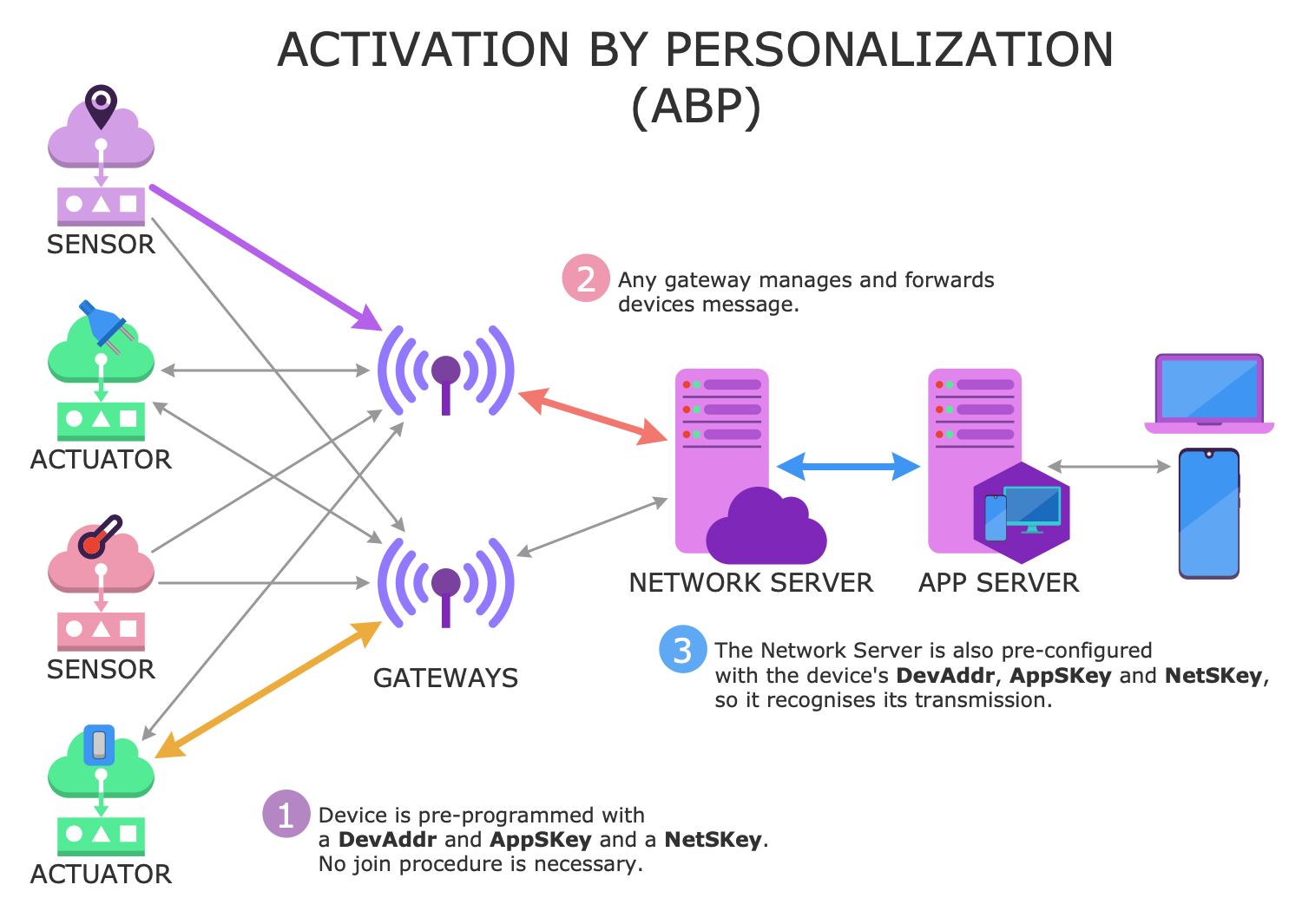
Example 2. Chain of Home Devices (Including IoT)
This diagram was created in ConceptDraw DIAGRAM using the libraries from the Internet of Things Solution. An experienced user spent 10 minutes creating this sample.
This sample shows a chain of home devices protected by passwords or pins. Many of them refer to IoT. These include common computing devices such as smartphones, tablets, laptops and PCs, workstations, servers, CDs, DVDs, Blu-rays, printers, webcams and video recorders, cameras, smart TVs, digital clocks, smart watches, home appliances, home automation devices including thermostats and security systems, toys for children with Wi-Fi, intelligent cars, and many others. IoT devices are vulnerable and attractive targets for cybercriminals. Therefore, reliable protection is a need for IoT devices both at home and the enterprise. Passwords help to secure your devices, protect from breaches, and keep threats and attacks. As a rule, IoT devices are supplied with preset passwords. However, once a new IoT device is connected, it is recommended to change its password to a strong, complex, difficult-to-guess, and unique to each device. In addition, update your passwords from time to time. The multi-factor authentication is also used for IoT to provide extra protection and extra security.
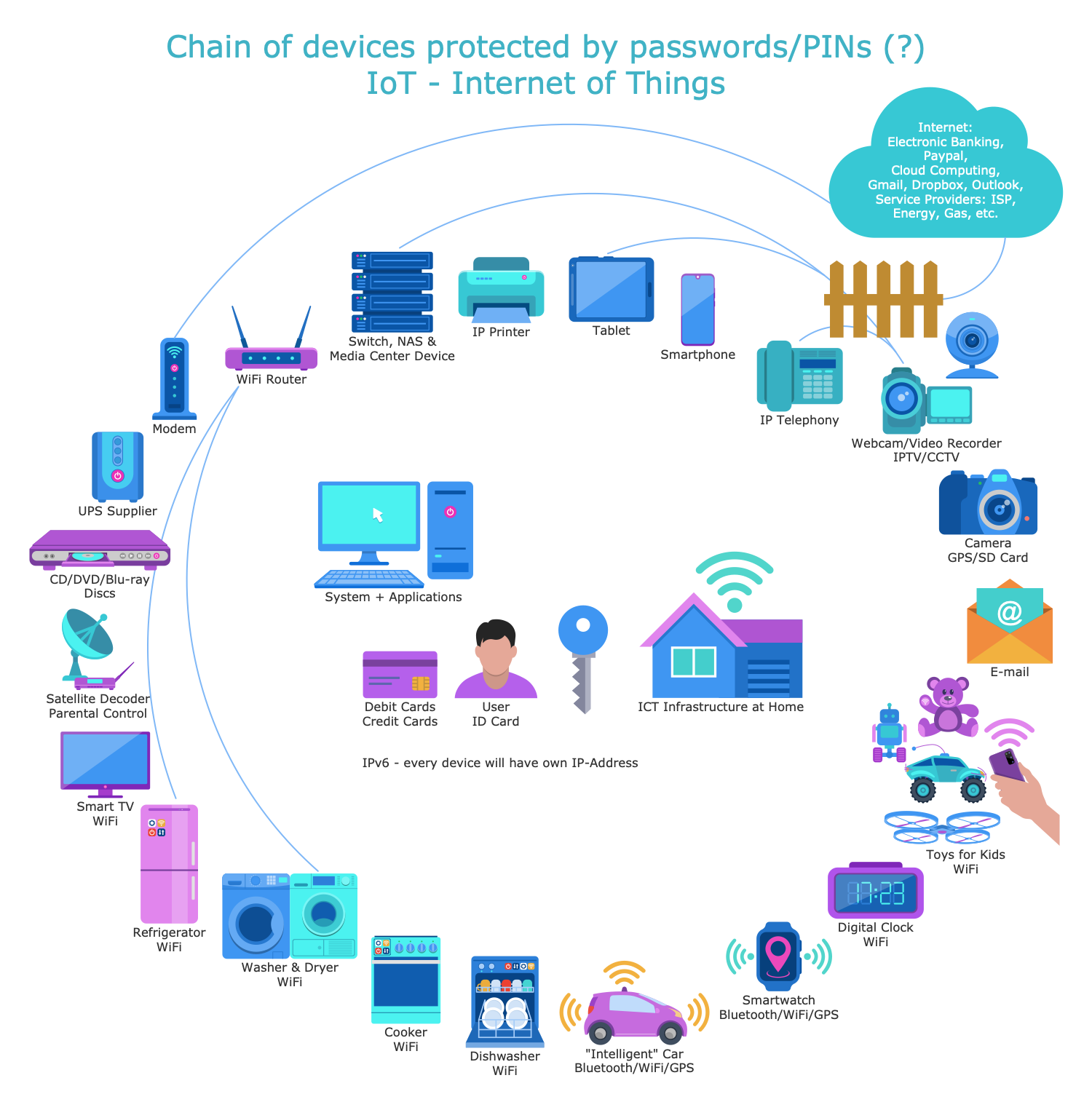
Sample 3. Connected Home
This diagram was created in ConceptDraw DIAGRAM using the libraries from the Internet of Things Solution. An experienced user spent 5 minutes creating this sample.
This sample is dedicated to the automation of a house and turning it into a smart home using IoT devices connected to the Internet. A home automation system includes various devices to monitor and control home appliances, home robots, home security systems, alarm and access control systems, entertainment systems, detectors and control panels to adjust the temperature, lighting, and sometimes the integration of the solar panels, etc. A home automation system helps to maintain a comfortable climate in a home through regulation of heating, air conditioning, and ventilation. It helps to save energy, provide clearness, safety, leak detection, smoke and CO control. It can also offer functions of sharing data between family members, tracking pets' and babies' movements. As a rule, all home automation devices are connected to a central smart home hub or a gateway. Smartphones, tablets, laptops, and wall-mounted terminals are used for remote surveillance of the cameras and control of the devices in real-time via the Internet and using specialized applications. Voice control devices are also used.

Example 4. Enterprise IoT Data Chain Cycle
This diagram was created in ConceptDraw DIAGRAM using the libraries from the Internet of Things Solution. An experienced user spent 5 minutes creating this sample.
This sample shows the data chain from the water sensor to the cloud server through the data logger and modem. All these devices refer to the enterprise Internet of Things (IoT). Currently, businesses and enterprises widely use modern technologies and achievements including IoT. IoT devices with embedded electronic components, sensors, actuators, and software provide a lot of advantages, help to improve business processes, reduce manual work and increase business efficiency. The deployment of IoT solutions and services provides benefits for enterprises. Large amounts of data are collected by enterprises through the IoT and then processed and analyzed using cloud and big data technologies. The information is taken from sensors embedded in various devices and equipment. Thousands of sensors and devices are deployed in large industrial enterprises. Enterprise IoT provides an advanced level of automation, scalability, and intelligent insights, faster, accurate and appropriate decision-making, encourages business and improves enterprise efficiency, facilitates development and implementation of new business models.
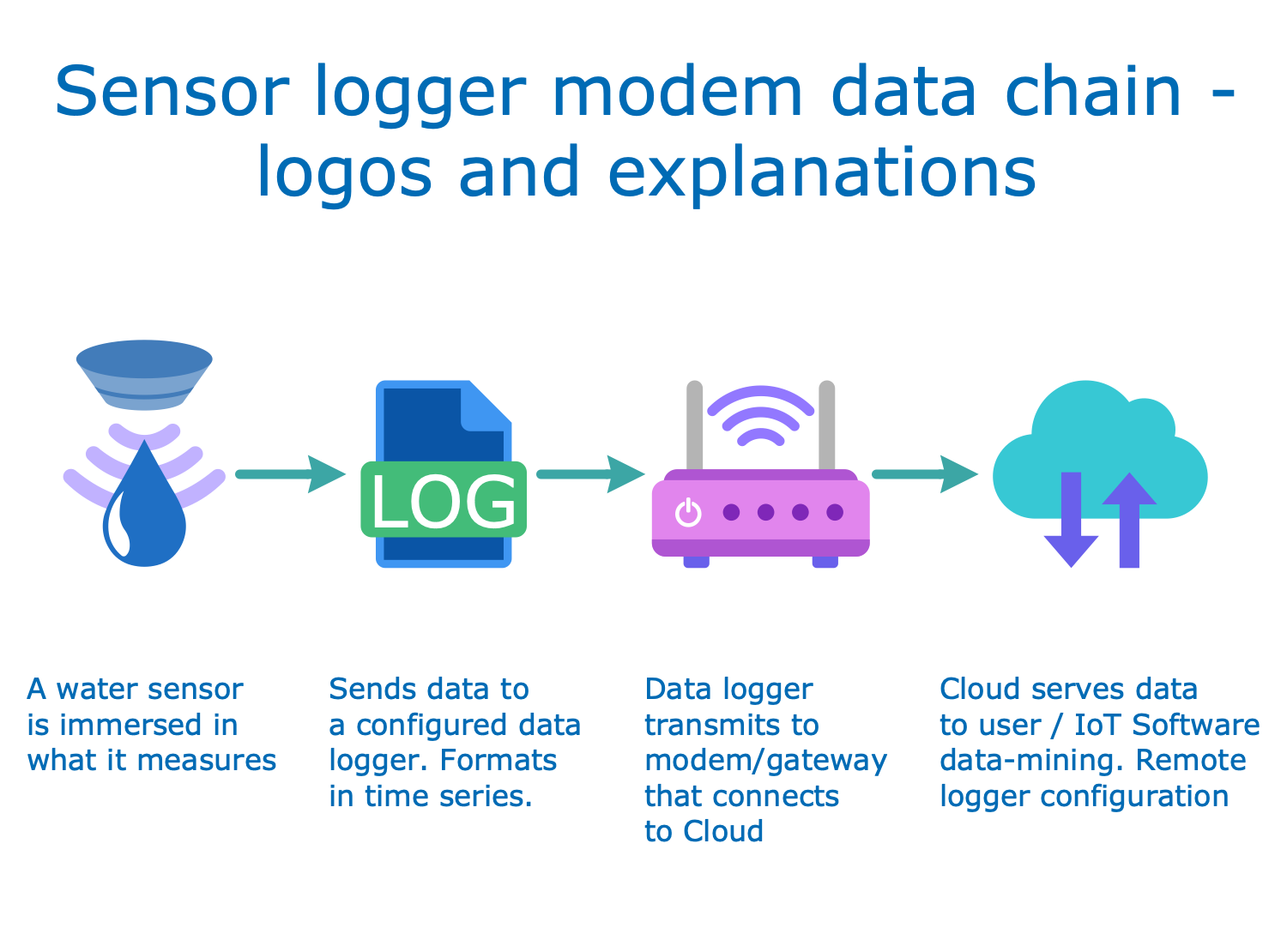
Example 5. Future Power Grid
This diagram was created in ConceptDraw DIAGRAM using the libraries from the Internet of Things Solution. An experienced user spent 10 minutes creating this sample.
This sample shows the transmission and distribution of electricity flow in a power grid. Both conventional and renewable electricity is currently in use for enterprises of different scale. The current tendencies show that the future power grid will be bidirectional and intelligent. Intelligent infrastructure includes renewable energy resources, smart meters, smart distribution boards, smart circuit breakers, load control switches, smart appliances, and other smart equipment. Electricity is transmitted across long distances through high-voltage power lines. Further, it is stepped down to medium-voltage and then is converted to low-voltage at the electrical substations to be distributed to homes and small businesses. The power of different voltages is distributed to enterprises of different sizes. Heavy industry and medium enterprises are powered by high-voltage and medium-voltage transmission lines respectively.
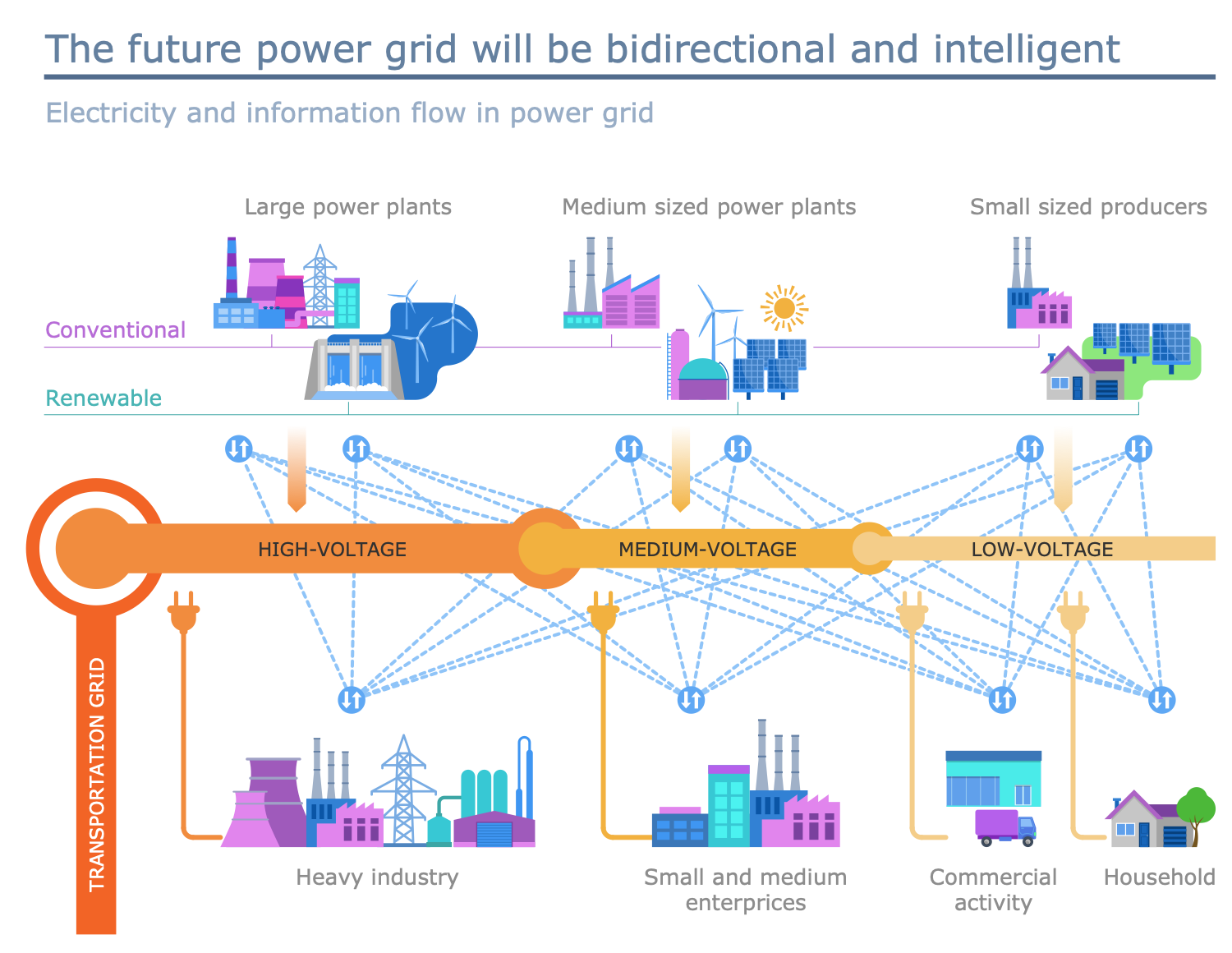
Example 6. IIoT Architecture
This diagram was created in ConceptDraw DIAGRAM using the libraries from the Internet of Things Solution. An experienced user spent 10 minutes creating this sample.
This sample shows the layered architecture of the Industrial Internet of Things (IIoT). IIoT includes industrial equipment, devices, and instruments with built-in sensors and special industrial applications installed. They are connected in a network, collect, analyze, and exchange data, realize remote monitoring and control in automated mode, without human intervention. IIoT provides a lot of economic benefits, helps to improve the productivity and efficiency of manufacturing processes, manage energy. It offers a high degree of automation and uses cloud computing to optimize process control, allows uploading and storing of files in cloud-based storage systems. The IIoT network layer usually includes physical network buses and communication protocols. The edge layer contains the physical hardware, the operating system that controls the processes on the devices, and the edge gateways that collect data and are located at the network edge next to the IoT devices. Edge computing supposes the data processing at the edge of the network, filtering, analysis, and necessary computations with data before sending into the cloud.

Example 7. Internet of Things (IoT)
This diagram was created in ConceptDraw DIAGRAM using the libraries from the Internet of Things Solution. An experienced user spent 5 minutes creating this sample.
This sample is dedicated to the wide application of the Internet of Things (IoT). The innovative Internet of Things technologies are used everywhere around us, in any business area, in many devices, using the Internet or any other network, anytime, and in varied contexts by many people. They have played, inter alia, a significant role in the Fourth Industrial Revolution, which was based on rapid changes in industries and technological processes. 4 IR took place in the 21st century through the introduction of innovative technologies of smart automation and interconnectivity. The use of IoT technologies, smart devices and sensors, smart machines, cyber-physical systems, mobile devices, cloud computing technologies, and artificial intelligence made possible the automation of manufacturing, improving communication and monitoring of physical processes, efficient analysis and diagnostics issues without human intervention. As a result, this led to a significant shift in the development of the industry and improvement of its efficiency.
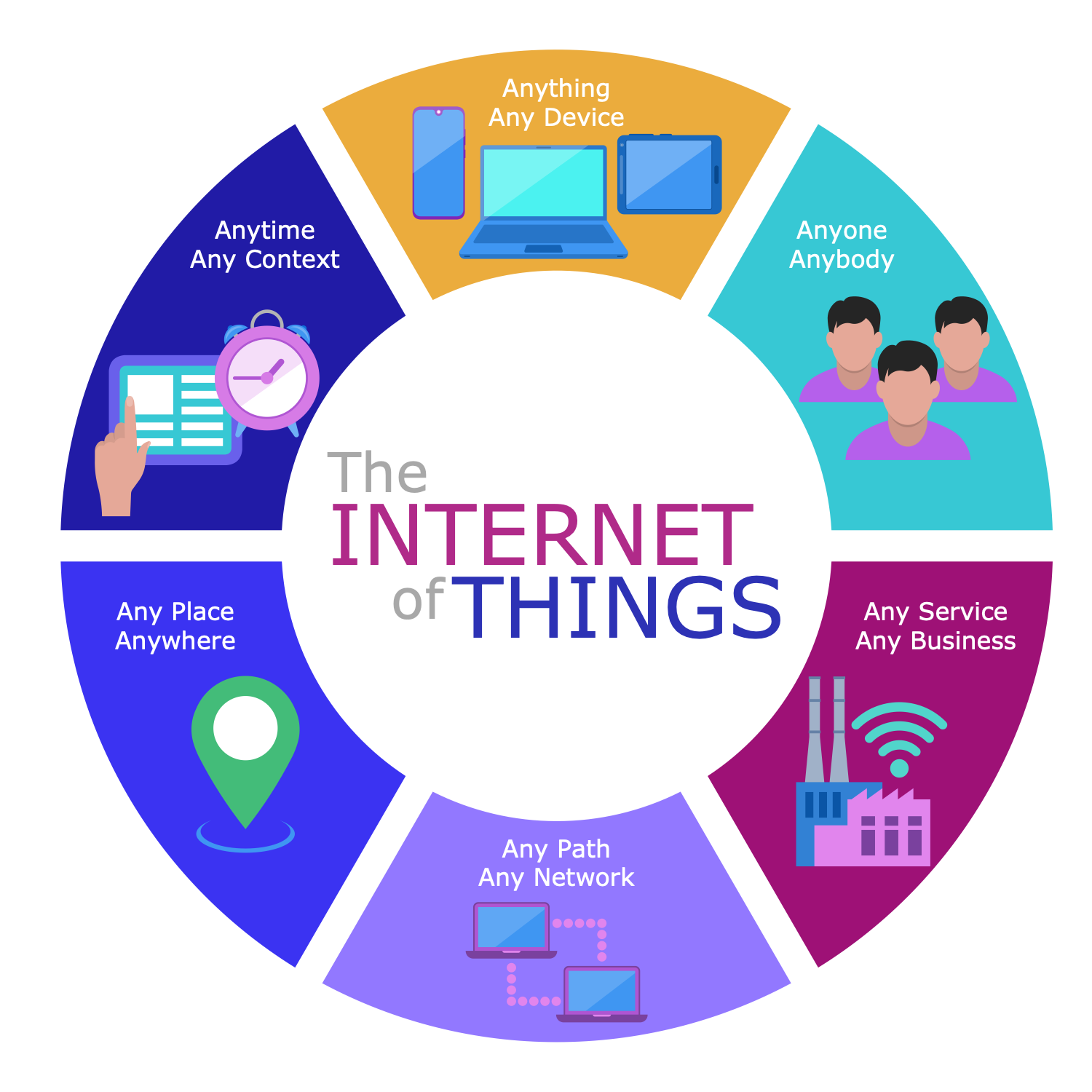
Example 8. IoT Applications
This diagram was created in ConceptDraw DIAGRAM using the libraries from the Internet of Things Solution. An experienced user spent 5 minutes creating this sample.
This sample shows numerous applications of the Internet of Things including commercial, industrial, consumer, and infrastructure applications. IoT devices and equipment are introduced and provide an operation of smart buildings, smart energy, smart transport, smart cities, smart health, and smart living overall. IoT devices acquire and analyze data from equipment, surrounding space, locations, and people. Home automation, conditioning, heating, lighting, and security systems are constructed of IoT devices. IoT technologies provide long-term benefits including energy saving and improved quality of life. Specialized sensors and biosensors are used in healthcare to monitor health, control blood pressure, heart rate, and implants, manage chronic diseases, capture and analyze patient health data. IoT technologies are applied in transportation systems, logistics, emergency notification systems, military, appliances with remote monitoring capabilities. They are used in residential areas to monitor the well-being of the elderly and chronically ill, in agriculture to collect data on temperature, humidity, precipitation, wind speed and other indicators. Intelligent IoT systems allow you to optimize the production process to increase productivity and reduce costs, provide control of critical infrastructure, intelligent traffic management, monitoring of mechanical, electrical and electronic systems.
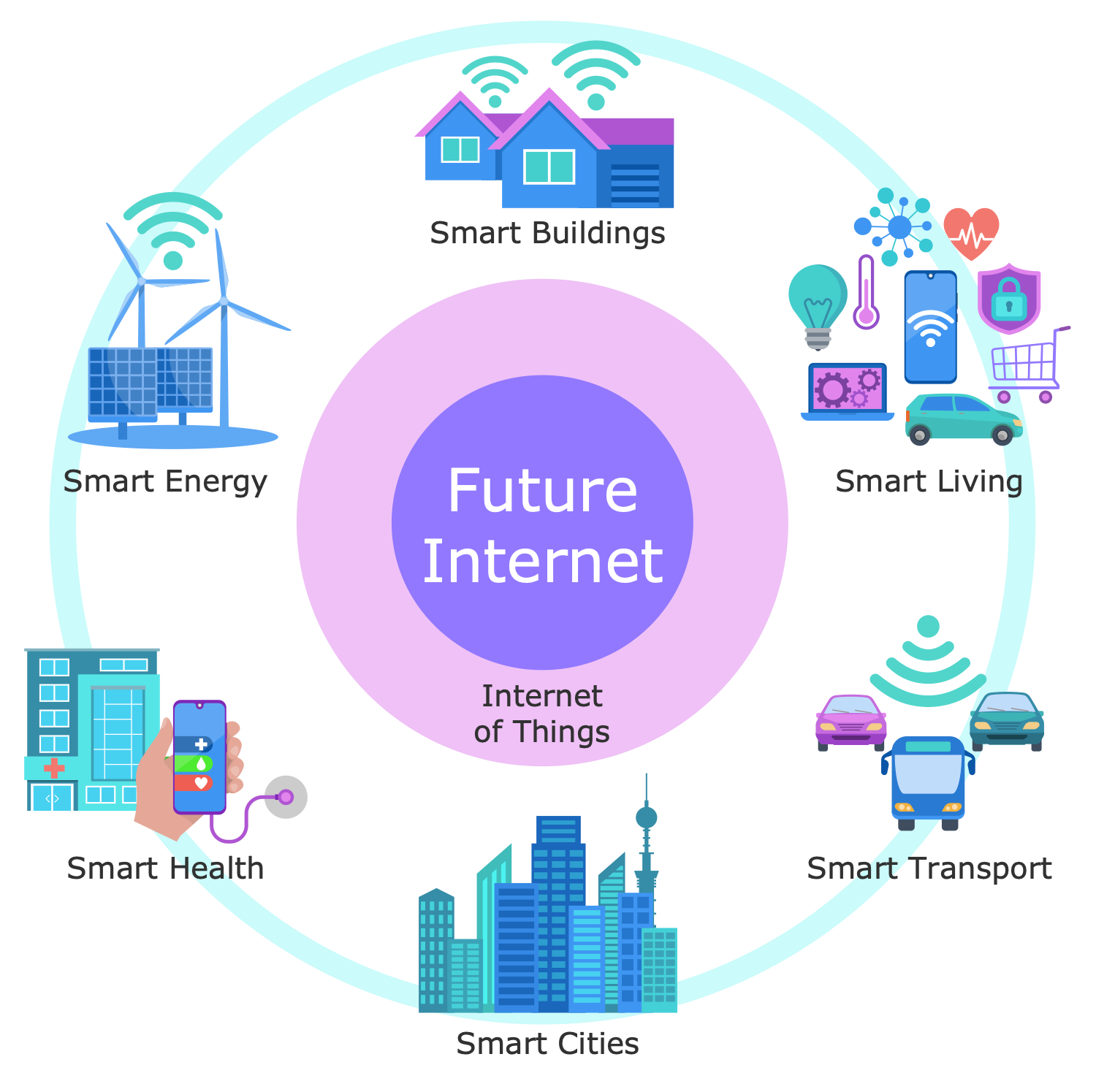
Example 9. IoT in Agriculture
This diagram was created in ConceptDraw DIAGRAM using the libraries from the Internet of Things Solution. An experienced user spent 5 minutes creating this sample.
This sample shows IoT applications in agriculture. Innovative digital technologies, wireless technologies, computer-controlled devices, automated systems, GPS guidance systems, sensors, and mobile technologies have numerous applications in agriculture and contribute to the improvement of agricultural and rural development, and increasing farm productivity. IoT help to collect and evaluate data on temperature, humidity, rainfall, wind speed, soil content and rate of fertility, water stress or excess, soil erosion, pest infestation, and other smart data. These data are further used in farming along with data about crop yield and diseases to provide efficient field monitoring and analysis, diagnose diseases at the early stage, prevent their spread, and increase the yield of various crops. IoT become increasingly popular in agriculture as a way to automate farming techniques, minimize risk and waste, improve quality and quantity of harvest, take informed decisions, and accurately apply fertilizers. Innovative methodologies and yield mapping help in the optimization of food systems and the entire agri-food value chain.
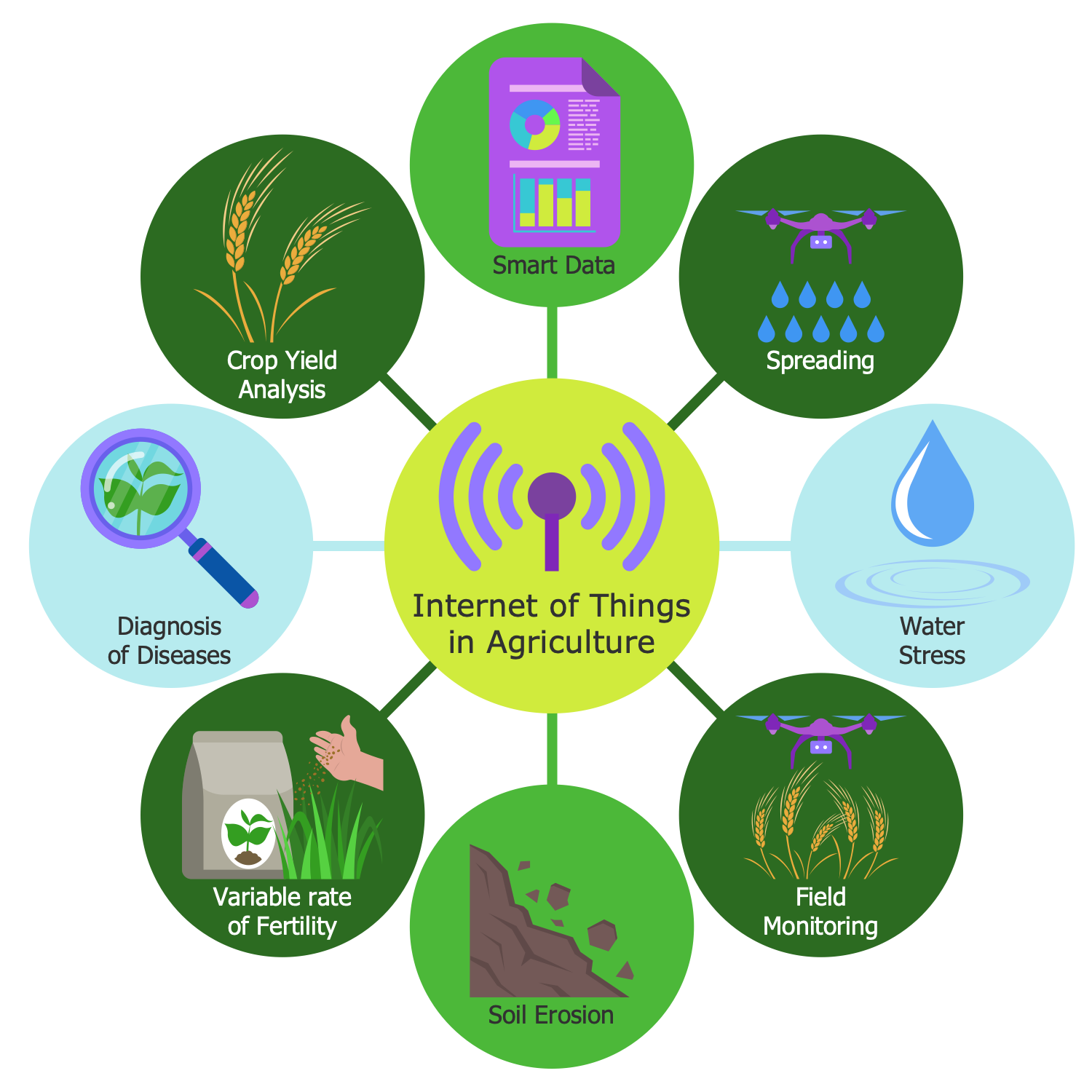
Example 10. IoT Sensors and Actuators
This diagram was created in ConceptDraw DIAGRAM using the libraries from the Internet of Things Solution. An experienced user spent 10 minutes creating this sample.
This sample shows a variety of sensors and actuators, which are part of IoT. A sensor is a device or module that detects certain events, phenomena, or changes in the environment and sends the information to other electronics. An actuator of a machine is responsible for moving and consists of a control device and a source of energy. As a rule, electric current, hydraulic pressure, or pneumatic pressure is a source of energy, and a valve is a control device. Once a valve receives a control signal, an actuator starts converting the energy into mechanical motion, linear or rotational. Sensors surround us everywhere; they are part of many household appliances, objects, devices and equipment. Window sensors, acoustic or sound sensors, motion sensors, smoke sensors, humidity or water sensors, temperature sensors, gas sensors, proximity sensors, fan sensors and many others are used for different purposes and have different sensitivities. Various IoT include sensors and software to process received data, they are connected to the Internet or other communications networks to exchange data with other devices and systems. The applications of sensors include household use, safety, machinery, manufacturing, robotics, medicine, agriculture, and other areas.
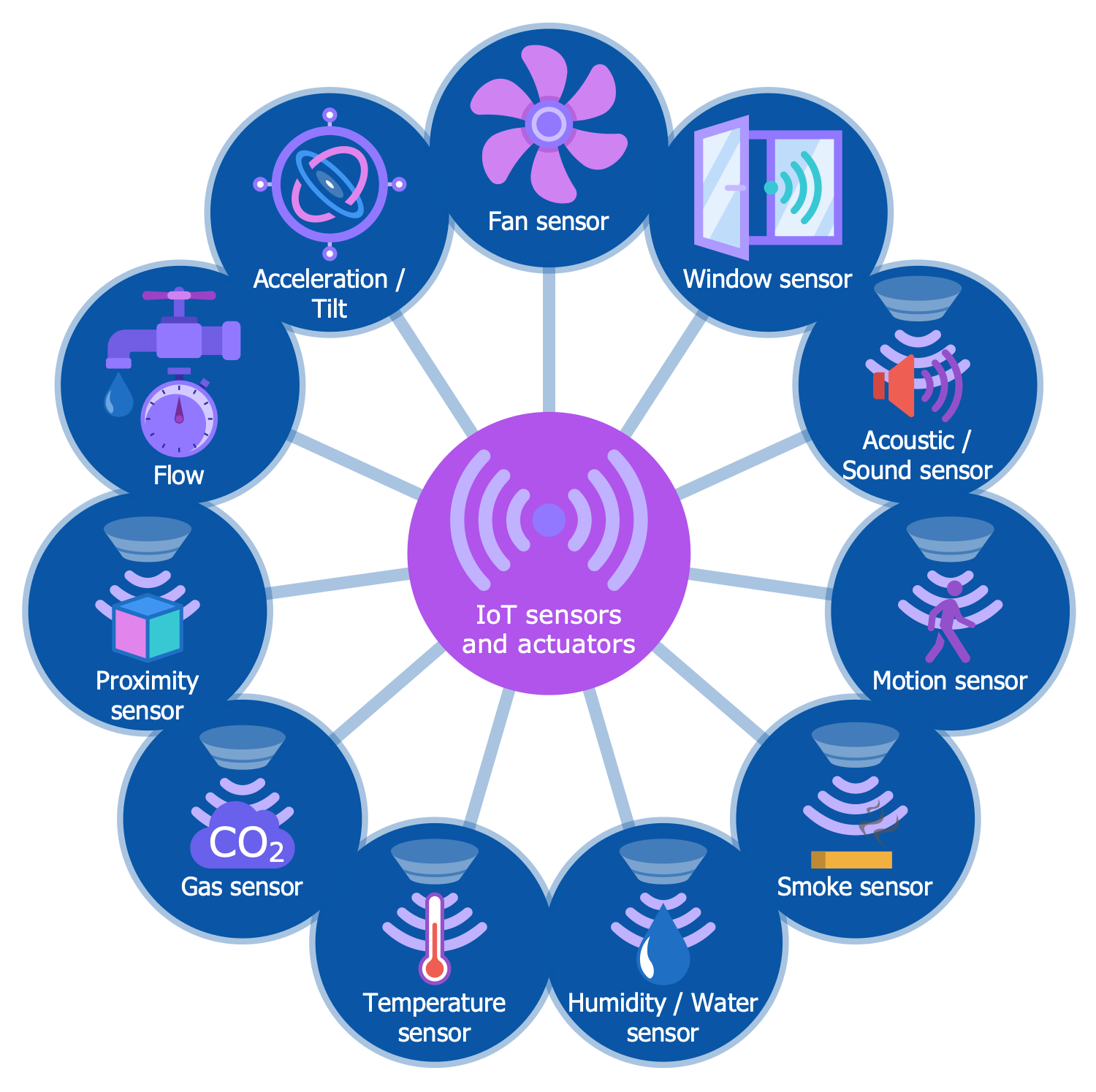
Example 11. Smart Grid
This diagram was created in ConceptDraw DIAGRAM using the libraries from the Internet of Things Solution. An experienced user spent 10 minutes creating this sample.
This sample refers to the smart grid and its general characteristics. A smart grid is an electrical grid enhanced by innovative smart IT solutions, smart equipment, smart home and consumer devices, power transmission and distribution upgrades, and the use of digital information and control technologies. It includes infrastructure metering devices, smart switches, smart distribution boards, circuit breakers, load management tools, renewable energy sources. The smart grid provides economical, high-quality and stable operation with low losses and high reliability and security of supply, controls the production and distribution of electricity, and regulates the behavior and actions of equipment and consumers connected to it. Deployment and integration of smart technologies, advanced energy storage and peak reduction technologies provide flexibility and dynamic optimization of network operations and resources, facilitate the process of connecting and maintaining equipment, maintain and improve the reliability, quality and security levels of the supply system.
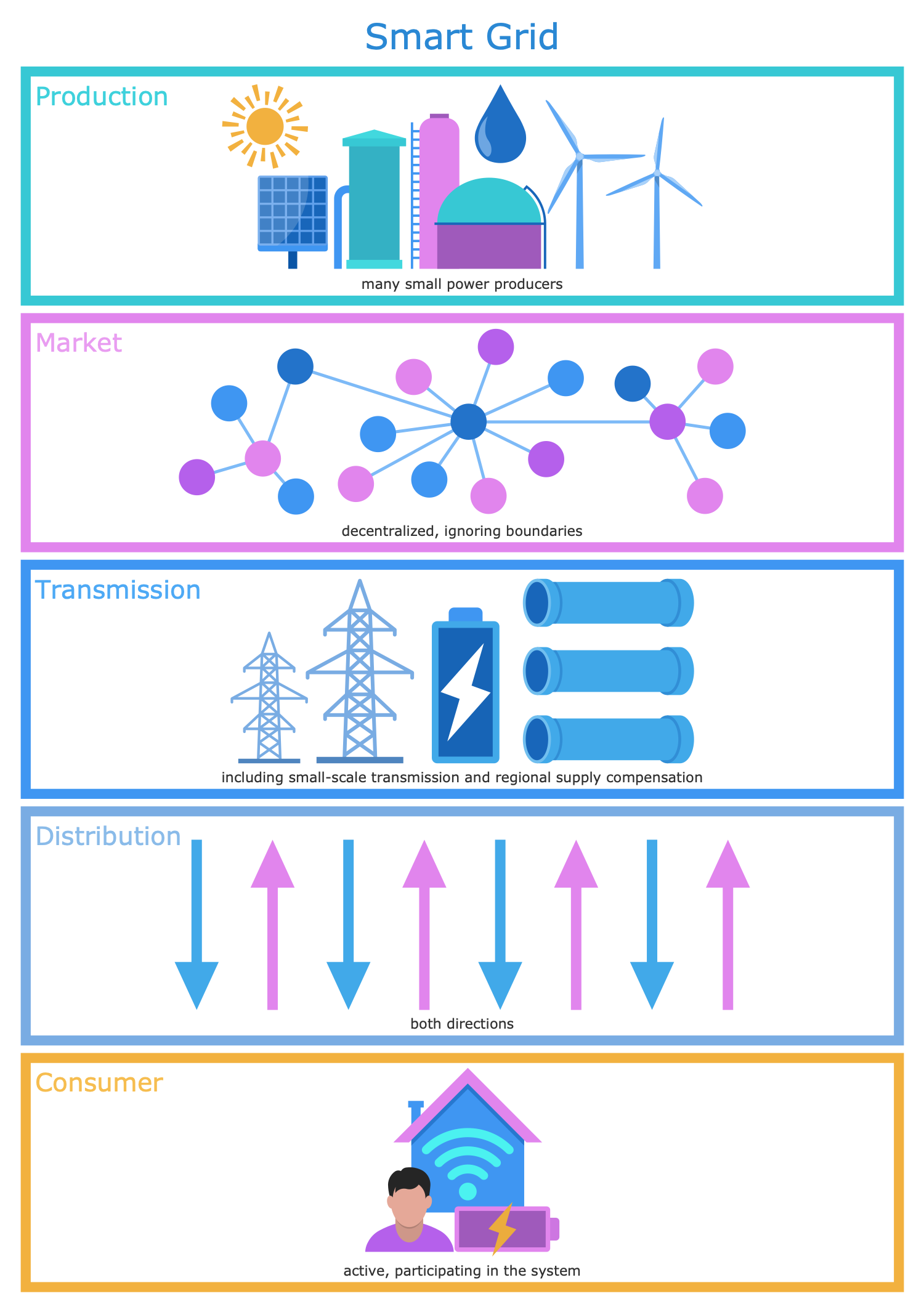
Example 12. Smart Grid Components
This diagram was created in ConceptDraw DIAGRAM using the libraries from the Internet of Things Solution. An experienced user spent 10 minutes creating this sample.
This sample shows common smart grid components: smart meters or microprocessor meters, smart switches, phase measurement units, transmission system generators, meter reading equipment, power flow control devices, distribution systems, wide-area monitoring systems, smart appliances, and many others. Smart grid components are used in manufacturing, telecommunications, power systems engineering, integrated communications, grid operations, power stations, home area networks, data centers, electricity data monitoring systems, substations automation, etc. They supply smart power generation, help to evaluate grid stability, improve equipment operation and energy management, automate distribution, track congestion and serviceability of equipment, diagnose grid outages or disruptions, take precise decisions to manage with them, prevent energy theft, provide control strategies support. Power flow control devices connected to transmission lines provide real-time control of energy distribution within the grid, support greater use of renewable energy, efficient storage of energy from renewables, load balancing, and elimination of interruptions in operation.
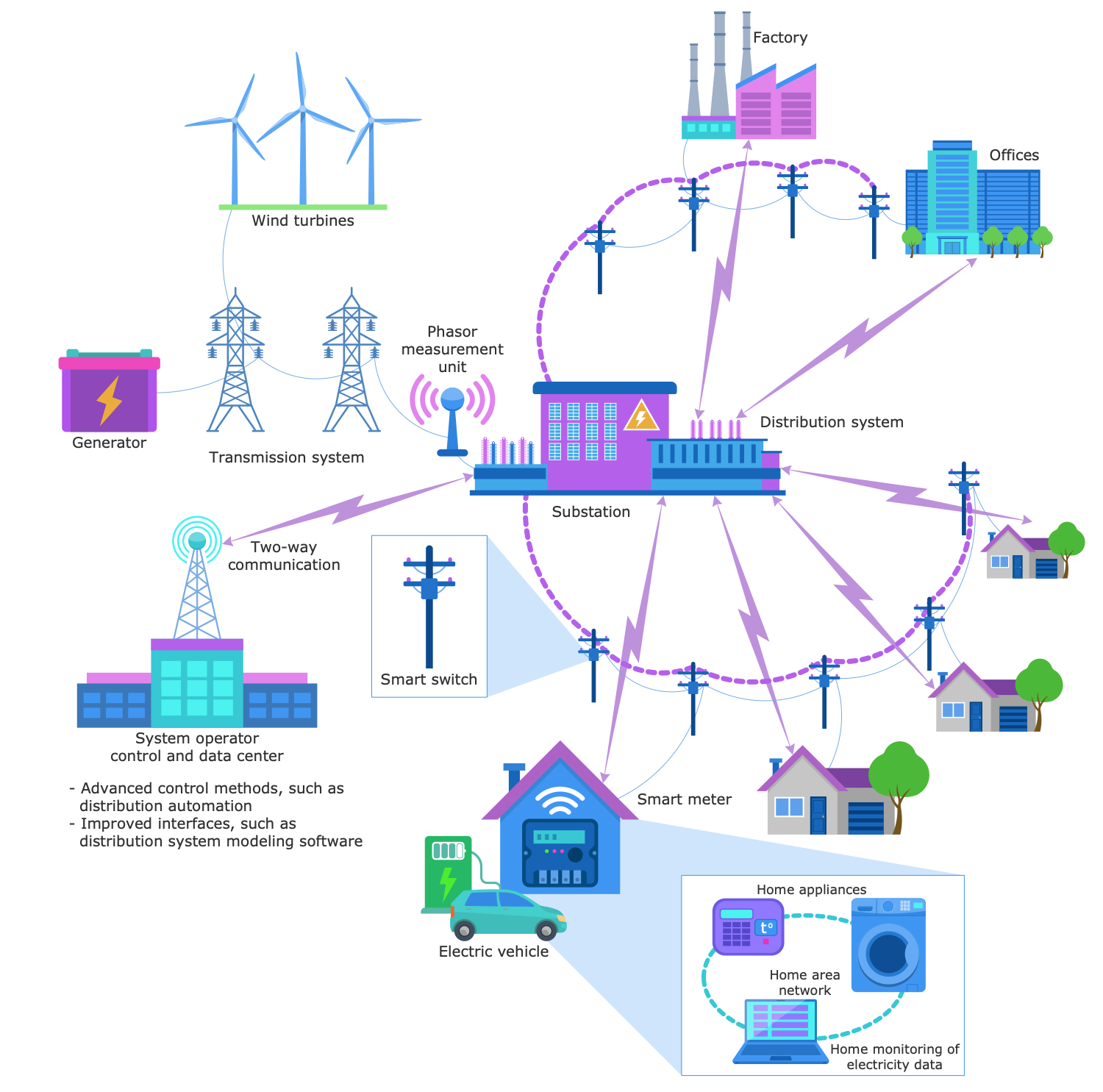
Example 13. Smart Home
This diagram was created in ConceptDraw DIAGRAM using the libraries from the Internet of Things Solution. An experienced user spent 5 minutes creating this sample.
This sample shows an IoT use case - smart home devices and smart home appliances. They make up an automation system and turn the house into a "smart home". A home automation system helps to monitor and control various attributes of a home. It provides remote control of temperature, lighting, heating, entertainment systems, adjustment of appliances and other devices. Home security system, alarm and access control also belong to the smart home. All home IoT devices are connected to a central smart home hub, the Internet or other communication network. Smartphones, tablets, wall-mounted terminals, and other electronic devices with special applications installed or a Web interface are used to control the electronic systems. Home automation has great opportunities and advantages. It contributes to energy and time saving, security and safety, comfort, creating individual settings, sharing and analyzing data. The use of renewable energy systems in home automation also provides a positive environmental impact.
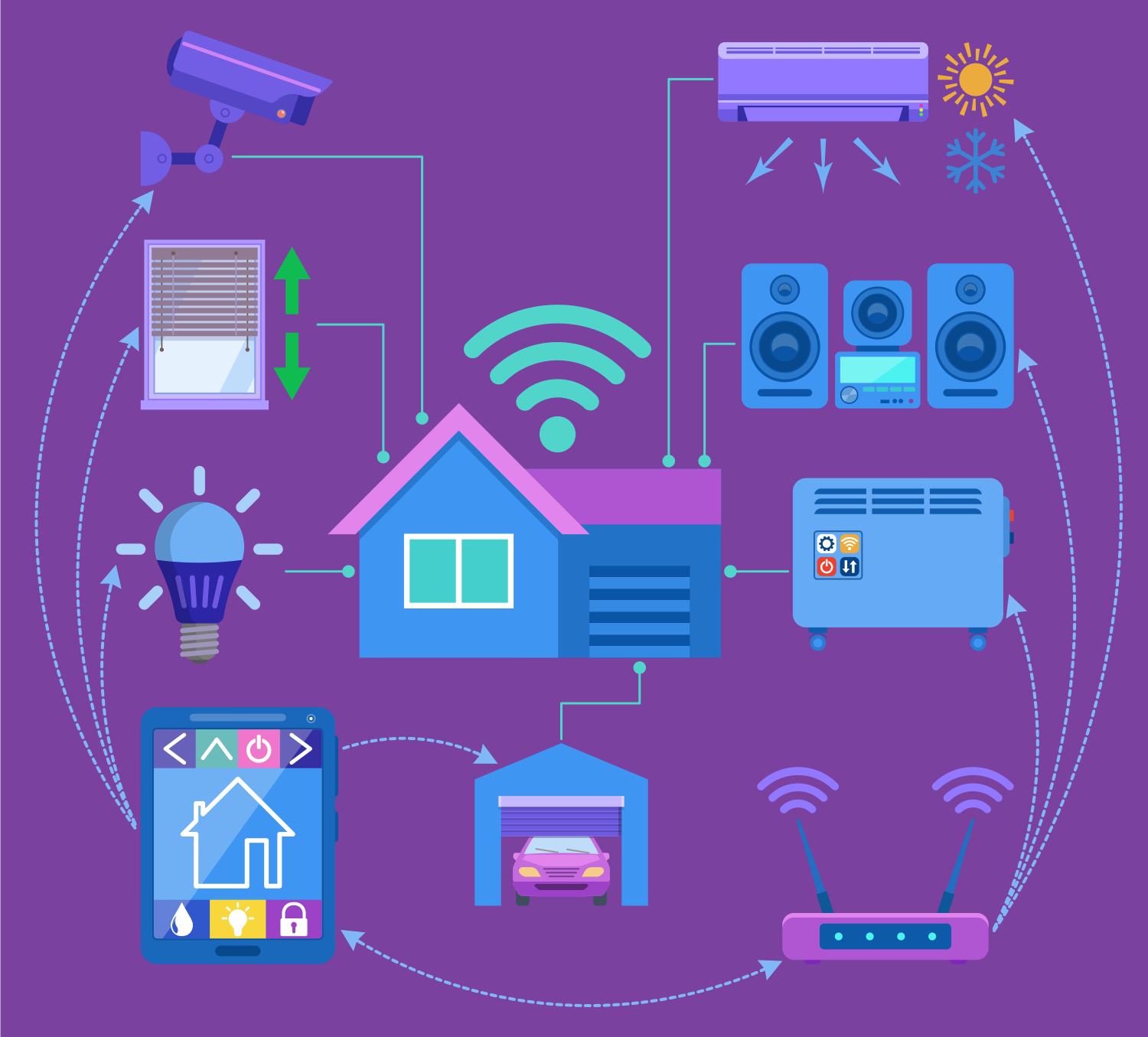
Example 14. Smart Retail
This diagram was created in ConceptDraw DIAGRAM using the libraries from the Internet of Things Solution. An experienced user spent 10 minutes creating this sample.
This sample shows the IoT application in the retail industry turning it into smart retail. The Internet of Things allows collecting of valuable information and data about products and the shopping lifecycle using various sensors and smart devices. The analysis of these data helps to improve product features, supply chain management and inventory management, increase the efficiency of the retail process and resilience of retail operations, and find ways to establish long-lasting relations with customers. The use of robots, network solutions, and IoT provides optimization of logistics, helps to automate retail process partially or fully, reduce maintenance costs and increase the speed of service, reduce waste and loss, improve accuracy and predictability, track equipment operation, and notify about any interruptions or faults. IoT sensors installed in retail stores and statistics of online orders help to analyze customers' habits and preferences to optimize product range and placement. GPS and RFID technologies used in IoT help track products throughout the supply chain and provide visibility into retail processes.
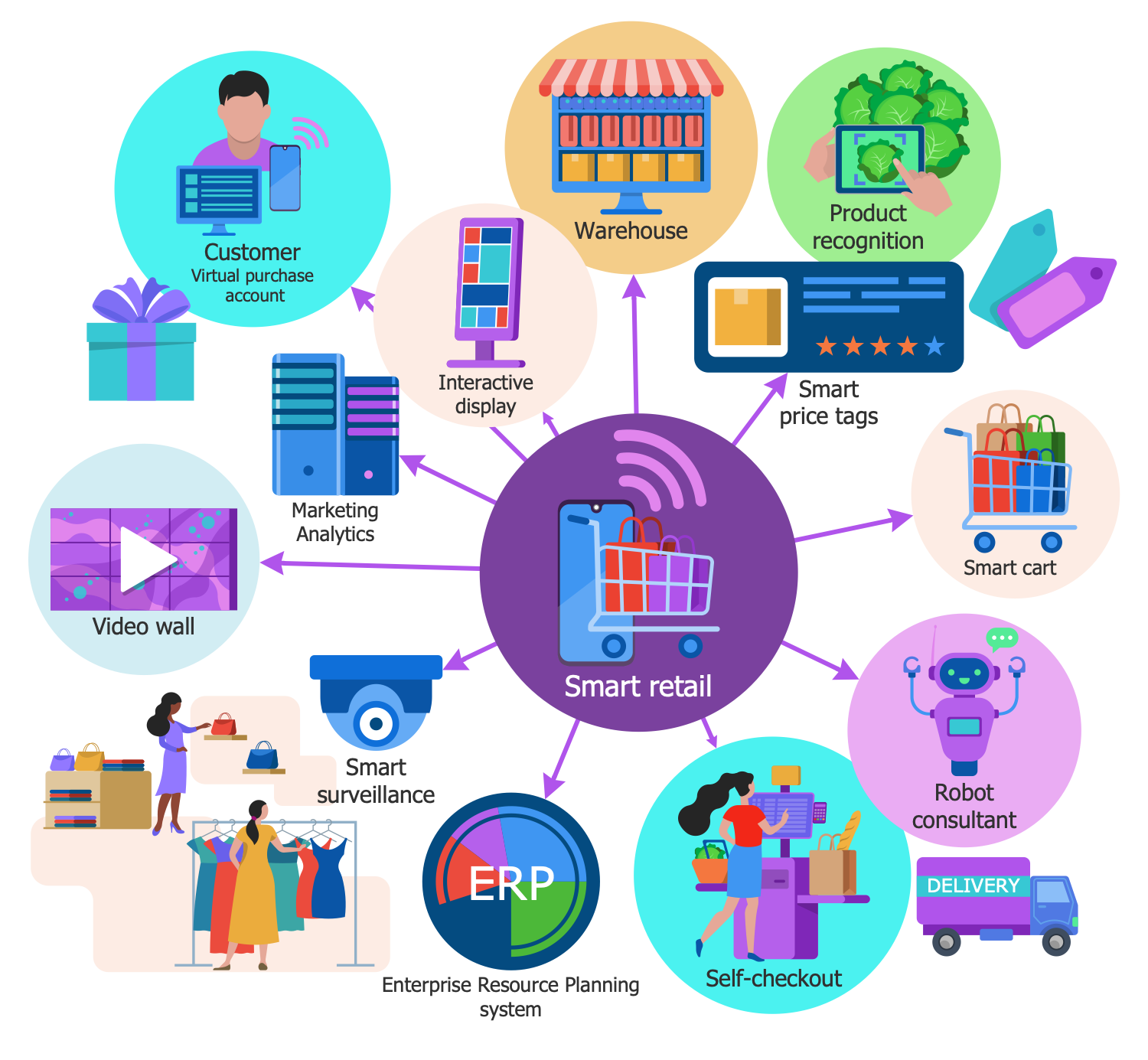
Example 15. Sustainable Transport
This diagram was created in ConceptDraw DIAGRAM using the libraries from the Internet of Things Solution. An experienced user spent 5 minutes creating this sample.
This sample is dedicated to clean mobility and sustainable transport, which is a way to avoid dirty traffic, prevent air pollution, clean the environment, and mitigate climate change. The transport sector is increasing faster than any other and has the most significant impact on the environment. Most of the world's carbon dioxide and greenhouse gas emissions, as well as particulate matter, also come from it. The sustainability of road, water, and air transport is measured by the environmental and climate impact. Electrical transport such as electric cars, tramways, and buses refers to sustainable and ecological transport. Moreover, sustainable transport has also social and economic benefits. The expanding grid of charging stations provides the convenience of using electrical transport for the owners. Active cycling, vehicle emissions control, demand-driven traffic management, use of renewable energy and renewable resources, and developments in solar energy research and production are also important for a cleaner environment and better public health through improved quality air.
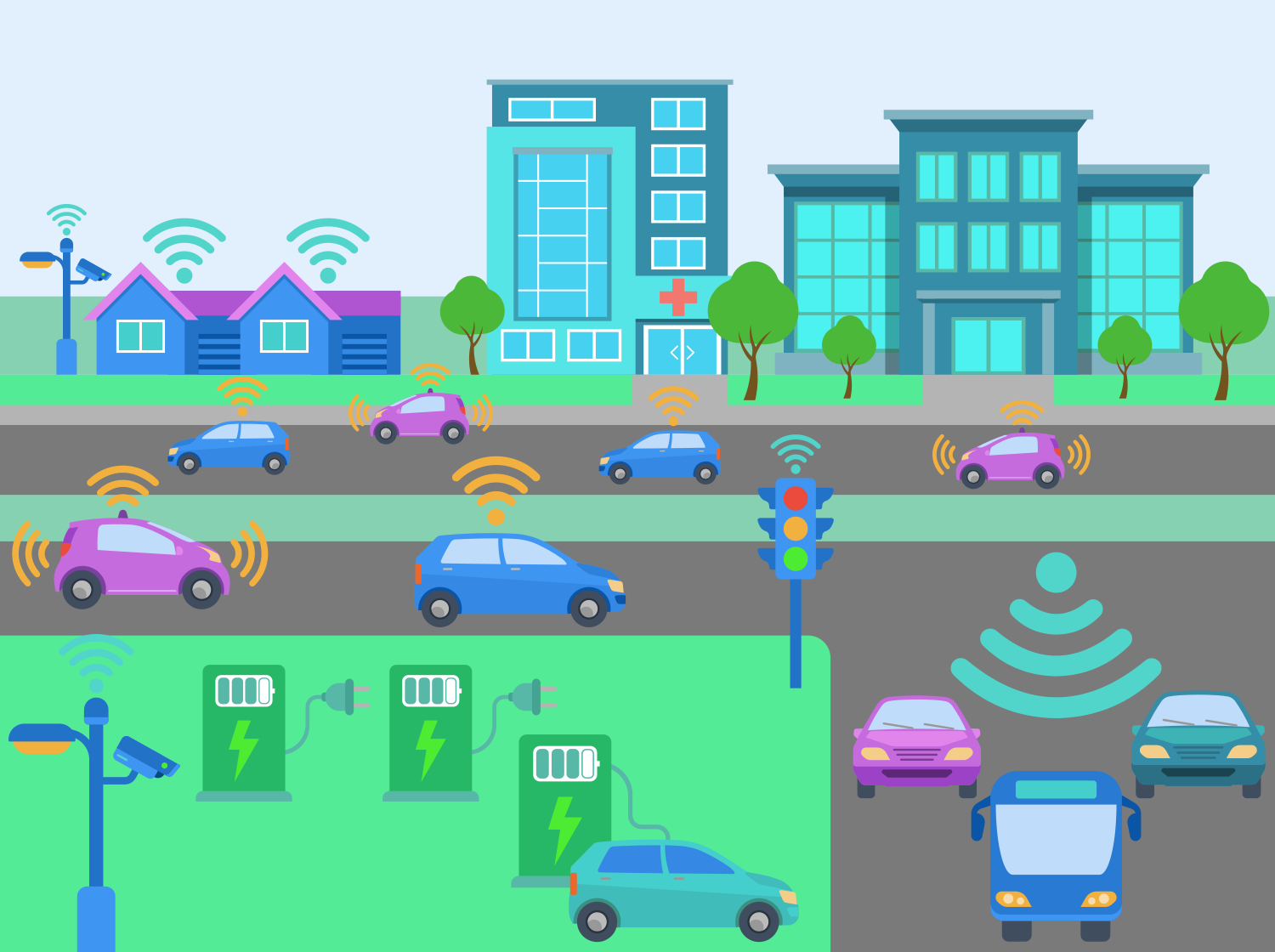
Inside
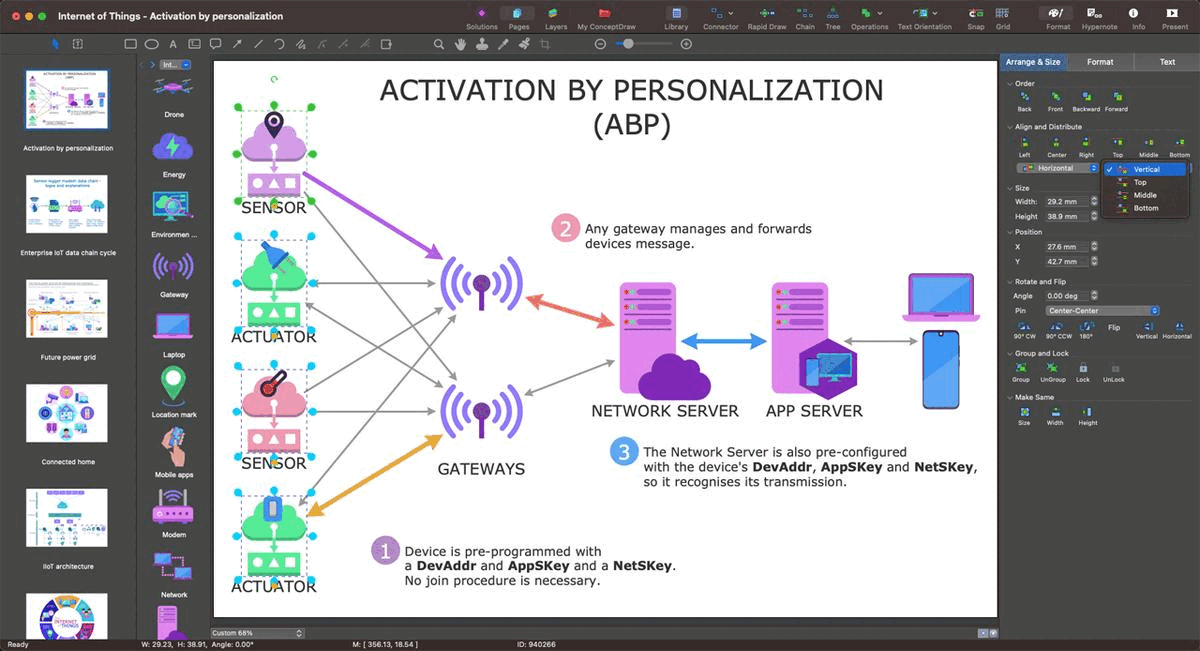
What I Need to Get Started
After ConceptDraw DIAGRAM is installed, the Internet of Things solution can be purchased either from the Computer and Networks area of ConceptDraw STORE itself or from our online store. Thus, you will be able to use the Internet of Things solution straight after.
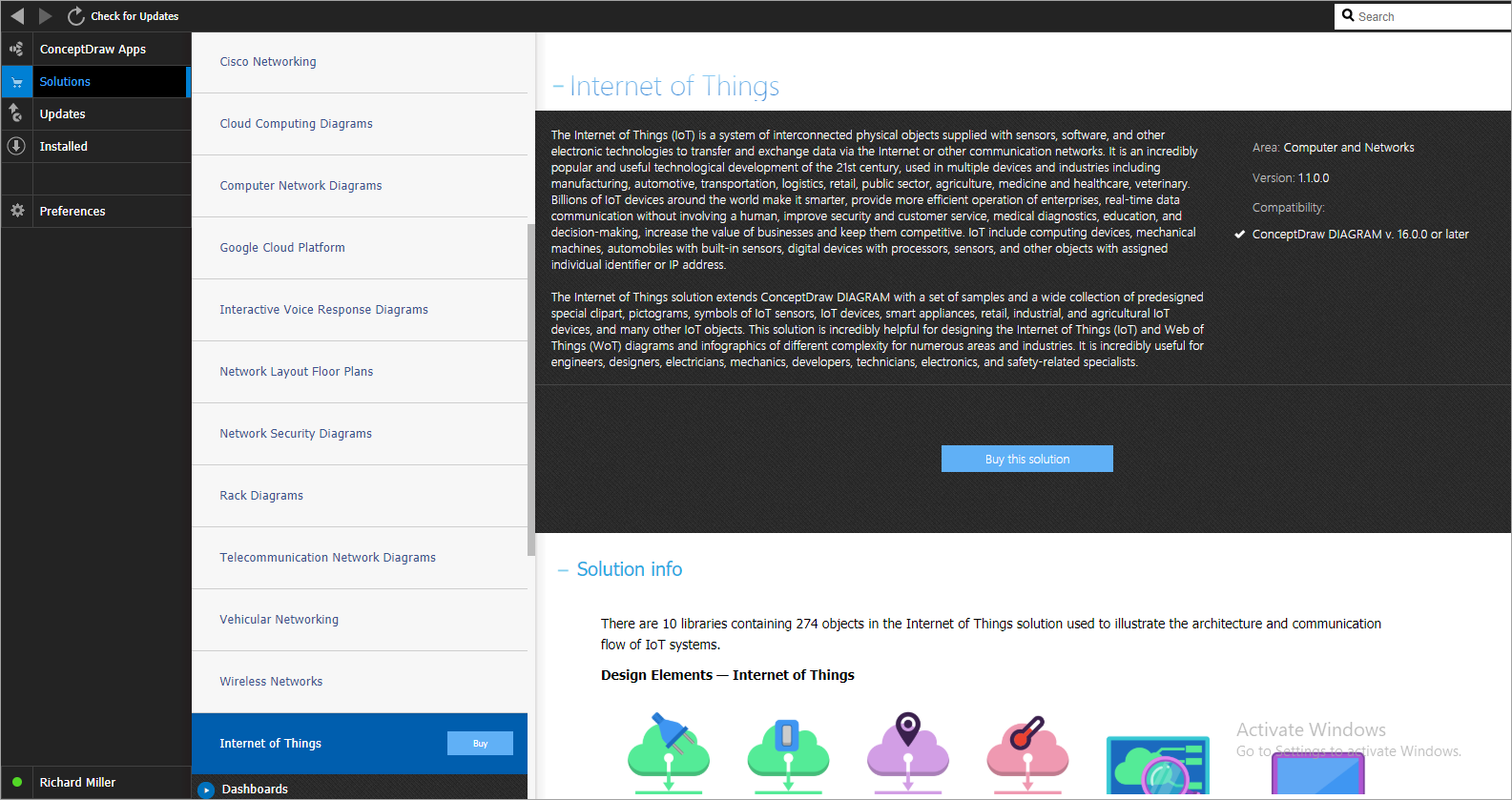
How to install
First of all, make sure that both ConceptDraw STORE and ConceptDraw DIAGRAM applications are downloaded and installed on your computer. Next, install the Internet of Things solution from the ConceptDraw STORE to use it in the ConceptDraw DIAGRAM application.
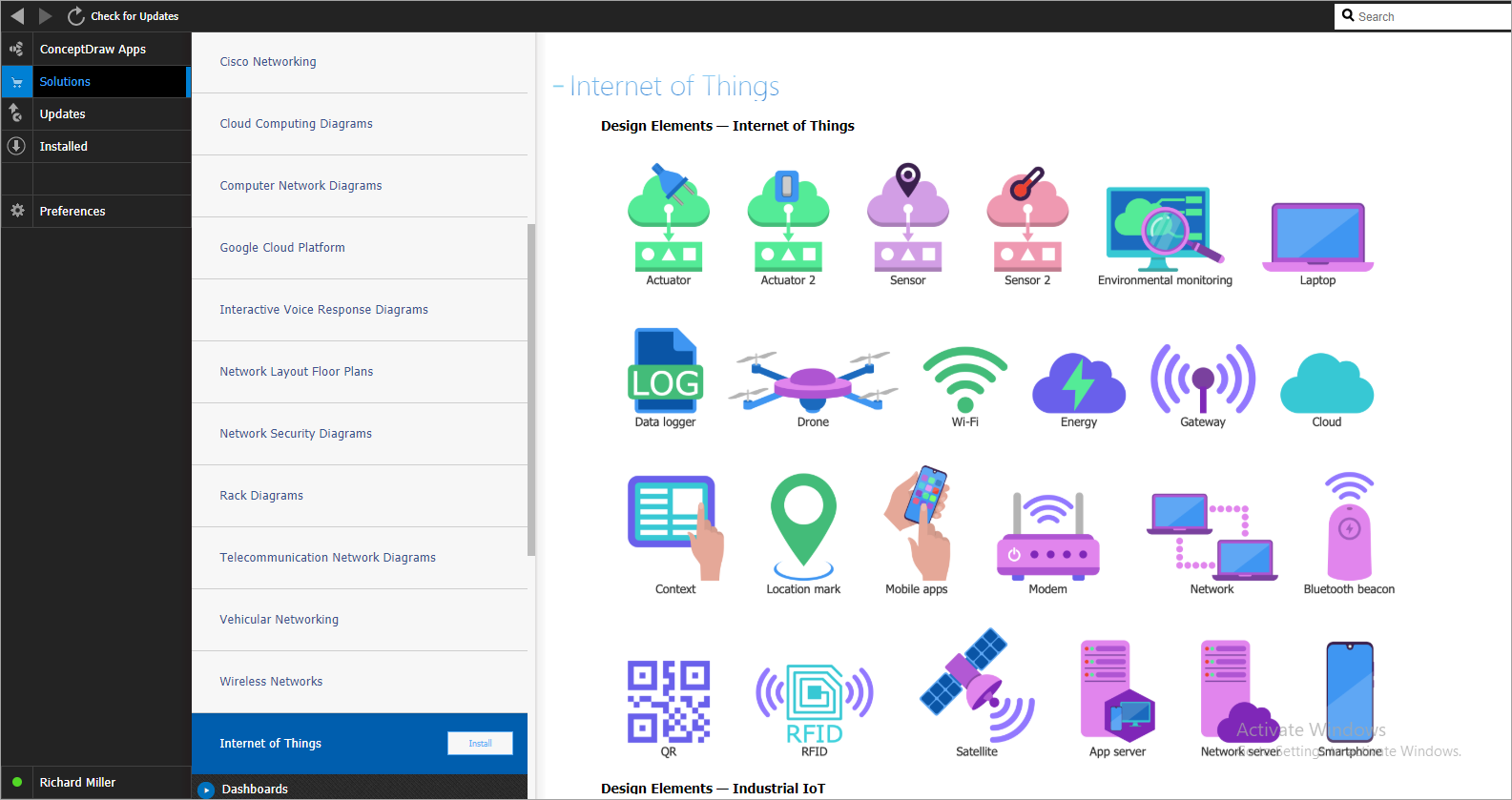
Start using
Start using the Internet of Things solution to make the professionally looking computer and network diagrams by adding the design elements taken from the stencil libraries and editing the pre-made examples that can be found there.
